Have you ever stopped mid-scroll to read an ad that just gets you?
It might have even convinced you to buy what it was selling. Or made you laugh and share it with a friend.
That’s effective ad copy in action.
Copywriting in general is snappy, engaging, and persuasive writing. Ad copy is a specific copywriting form, fine-tuned to achieve various marketing objectives through paid advertising.
In this article, you’ll learn what ad copy is and how to do it effectively.
What Is Ad Copy?
Advertising copy, or ad copy, is snappy written or spoken text in paid ads. It’s crafted to grab attention and pique your interest.
Its main goal?
To prompt action. Whether it’s making a purchase, signing up for a newsletter, hopping onto a webinar, or just discovering a new product.
For example, all the written words on this Heinz campaign form ad copy:
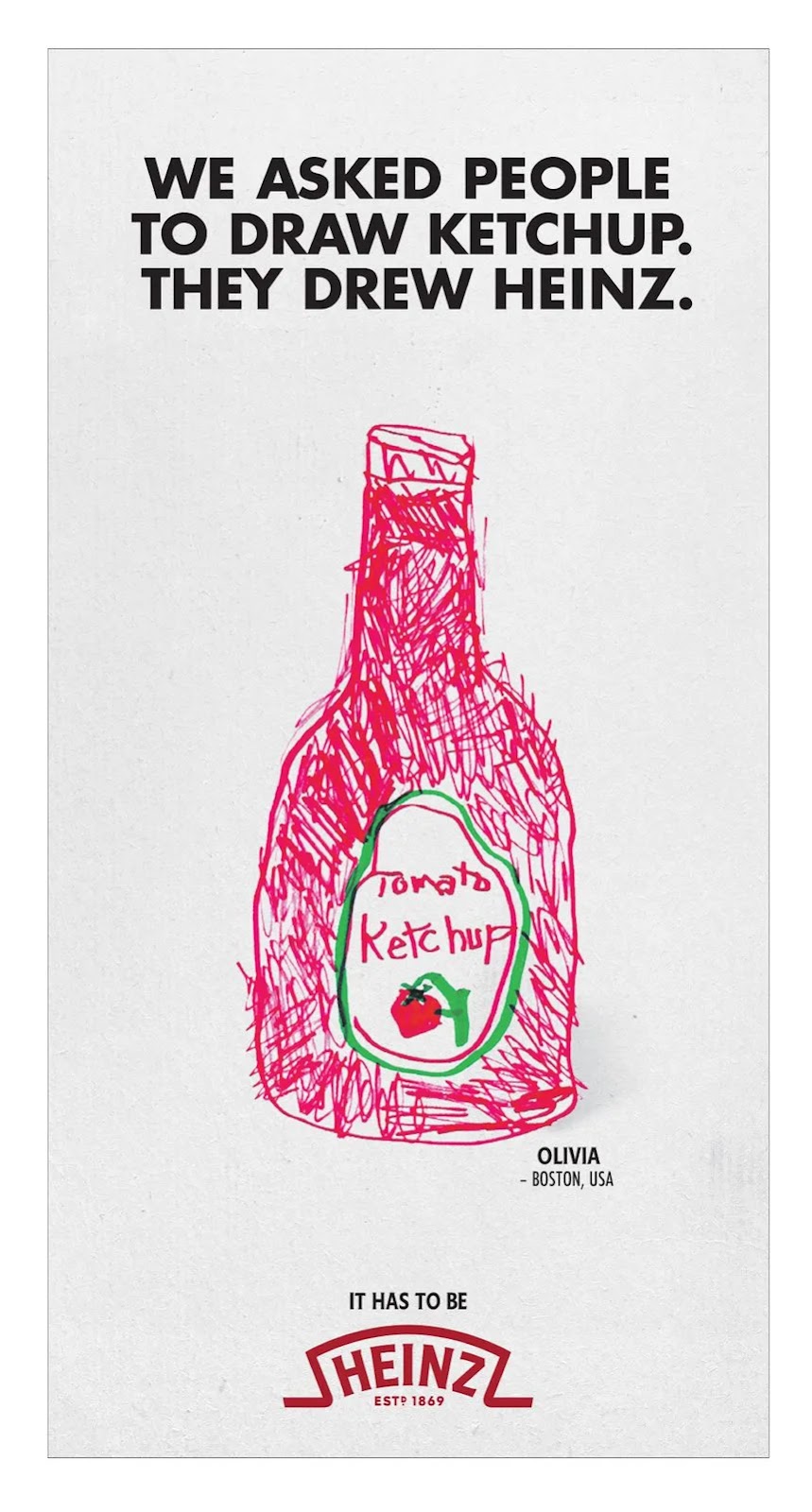
So are all the spoken words in this Reese’s video campaign:

The first campaign indirectly tells you that Heinz is the most memorable brand of ketchup and therefore must be the best. So next time you need to buy ketchup, you might be more likely to choose Heinz.
In the Reese’s ad, you’re tempted with visual and written imagery describing a delicious treat.
Notice how the two ads use different formats, but both attempt to convince you to buy their product.
Perhaps not right away. But maybe next time you plan a BBQ or need a chocolatey pick-me-up, you’ll think of your positive associations with this product and choose it over the competition.
This is the power of ad copy.
Why Is Ad Copy Important?
Ad copy drives conversions and helps make the brand “sticky” (or memorable). You’ll be hard pressed to find a brand that gets away with image-only or non-narrated, video-only ads.
Even the powerhouse players, well-known internationally, use ad copy. Like Apple and Netflix.
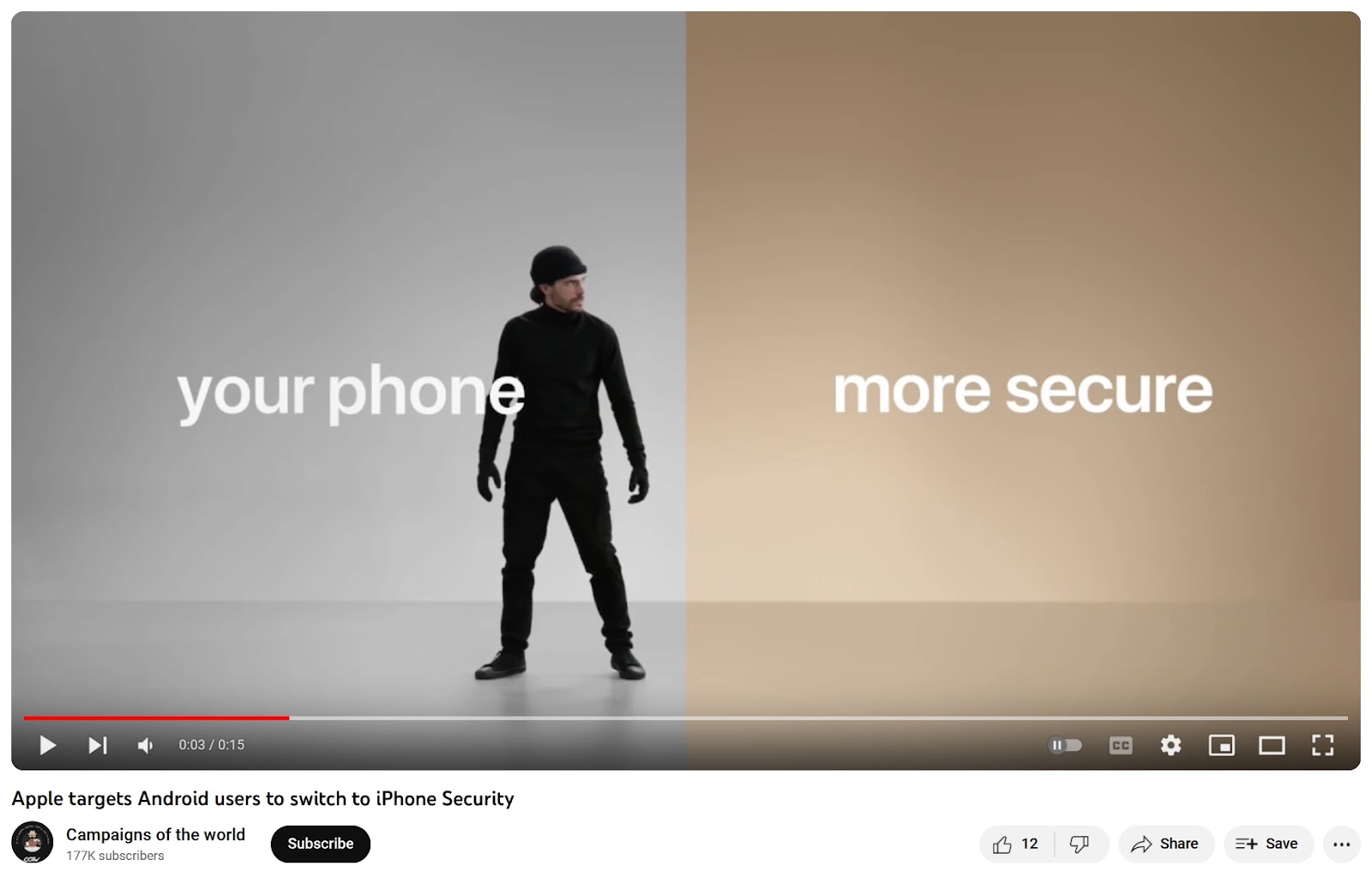
There’s almost always a need for words that communicate the message and tell the viewer what to do. Whether they’re spoken words or written in the ad.
Ad copy can creatively explain what you can expect from the product or brand. It might be an “irresistible, chocolatey taste” or a more secure mobile phone.
Effective ad copy convinces you to take the next action, like buy now or learn more. Or it sets the brand in your mind so you think of it next time you need it.
Ad Copy for Different Digital Channels
Just as there are many different types of ads, there are many ways to write ad copy. For starters, it can be offline or online.
Offline ads comprise media like billboards, newspaper ads, and public transport posters. Online ads appear anywhere on the internet, such as websites, social media, and even your inbox.
The format, length, and how quickly you need to communicate your message all depend on where readers will see your copy. Some channels may allow you to express more brand personality than others.
To learn more about these parameters, let’s take a look at what ad copy looks like on five digital channels.
Social Media Ad Copy
Social media ad copy appears on ads on social platforms like Instagram, Facebook, and Snapchat.
Social media is an incredibly competitive space. You have to compete for attention with other ads, memes, cat videos, friends’ life updates, etc.
But these platforms are also incredibly popular—4.88 billion people use social media globally. If your audience is on your chosen platform, there’s a good chance they’ll see your ad.
Most people use social media for entertainment. So your social media ad copy must do one or both of these things:
- Be entertaining
- Stand out in a sea of other entertainment
For example, here’s a brand mashup by Ruggable and Morris & Co with the ad copy “Intricately Decorative. Simply Washable.”:

Just four words tell you exactly what you’re meant to know: Now you can get washable rugs with a William Morris design.
The copy is brief, clever, and informative. Accomplishing what it needs to communicate alongside the image (typically called “the creative”).
Fans of either brand may stop scrolling when they see the beautiful rugs. Then, learning that the rugs are uniquely washable may convince them to tap the “Shop Now” call to action (CTA).
Further reading: Learn more about effective social ad copy in our Beginner’s Guide to Social Media Advertising in 2023.
Paid Search Ad Copy
Paid search ads appear at the top of the search engine results page (SERP) when you search for a term online.
Pay-per-click (PPC) ads are a type of paid search ad where the advertiser only gets charged when users click on them.
Paid search ads rely on search terms, or keywords. For instance, if someone looks for “task organizing software,” they might see this “Sponsored” result for Wrike:
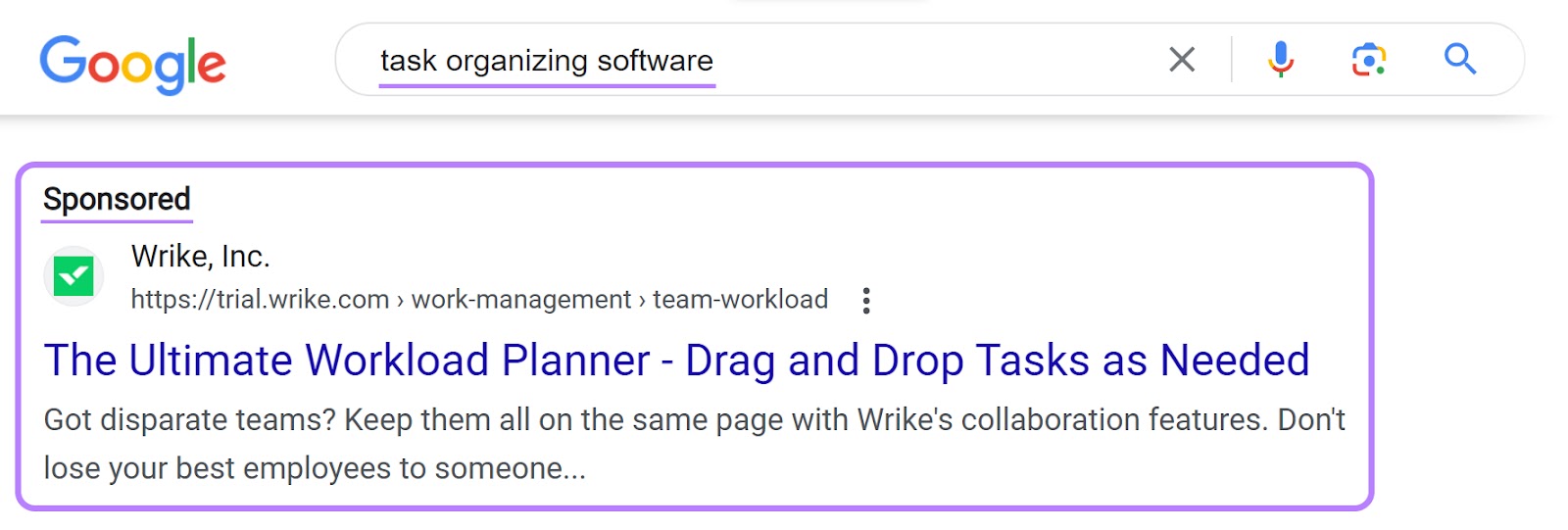
Search ad copy, therefore, is pretty straightforward. There isn’t a lot of room for creativity, unlike other ads where you might play off of strong imagery or video.
When it comes to search ads, you have strict parameters to work within:
- Display URL: The website URL that tells the searcher where they’re going if they click on the ad
- Headline: Where you communicate your main message and include the target keyword in 30 characters or less
- Description:The short paragraph below the headline where you can add more information in up to 90 characters
Let’s consider the search term “meditation app for sleep.” The app Headspace ranks as the first ad result in the SERP, followed by its competitor Calm.
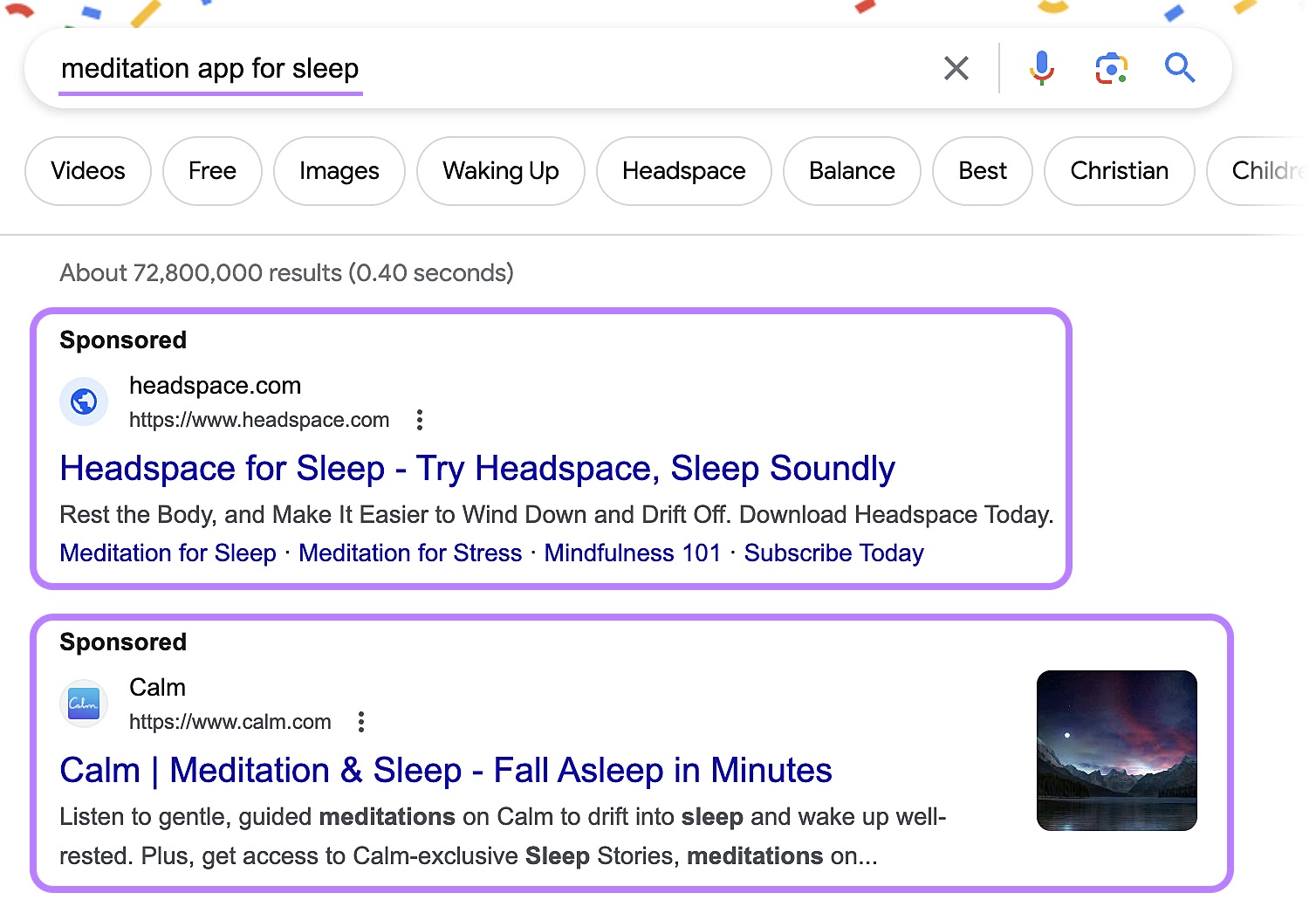
Both results include variations of the keyword in the headline. And focus on sleep.
Each URL tells the searcher they’ll head to the homepage when they click on the ad.
Both listings use the description section to detail what it’s like to use the app. Plus the results one can expect.
The top spot also includes the CTA “Download Headspace Today.”
So, how do you identify the right keywords to use in your paid search ad?
Start by brainstorming keywords you’d like to appear for in search. Refine your results or get even more ideas with Semrush’s Keyword Magic Tool.
Here’s how:
Enter a word or phrase you’d like to explore, and hit “Search.”

You’ll see related keyword ideas for your search ad. Along with their likely search intent, how difficult they are to rank for (KD %), average cost per ad click (CPC), and Competitive Density for your chosen keyword in PPC bids.
Search intent tells you whether a user just wants information or is looking to buy—important to consider so that you allocate your budget in the right place.
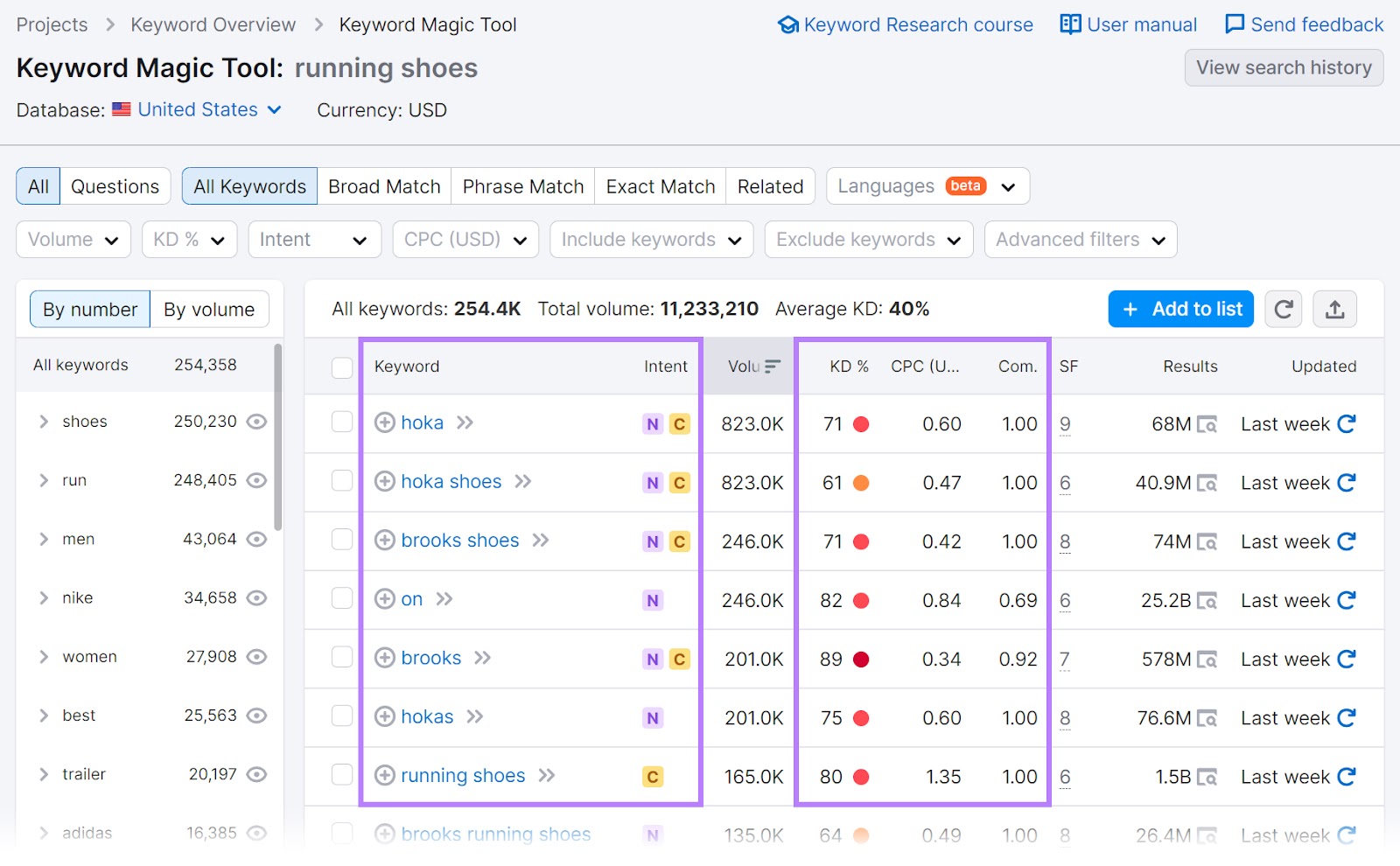
When you’ve narrowed your search and found your keyword, be sure to include it in your headline and communicate the benefits in your description.
Further reading: How to Create an Effective PPC Strategy in 7 Steps
Display Ad Copy
Display ads are graphic advertisements on websites, apps, and social media. Usually including a combination of copy, images, video, and sometimes audio.
At Semrush we use a type of display ad called a banner ad in blog articles like this one:
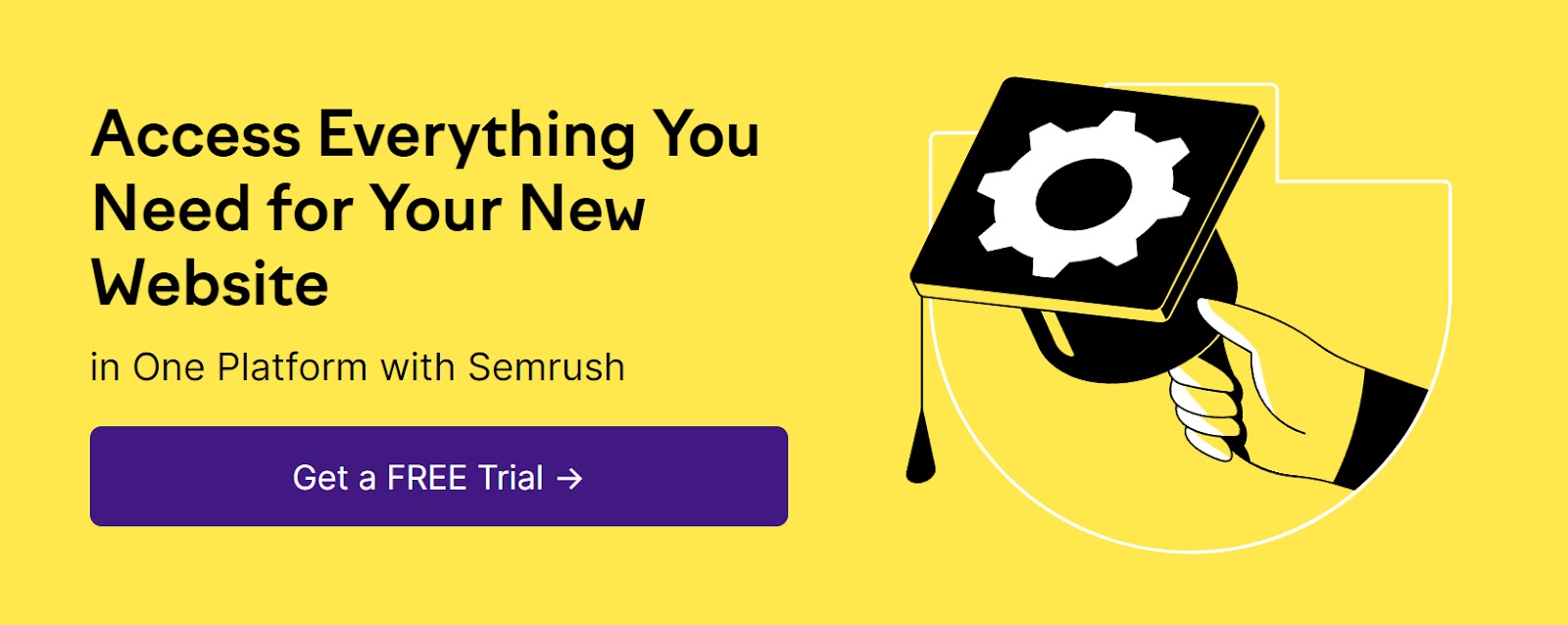
Display ads can come in different shapes and sizes. Depending on their placement on the website or social media channels, whether the viewer is on desktop or mobile, and so on.
Display ad copy must fit comfortably within these parameters so it’s clearly readable. Don’t be tempted to fill the space with text.
Here’s another banner ad:
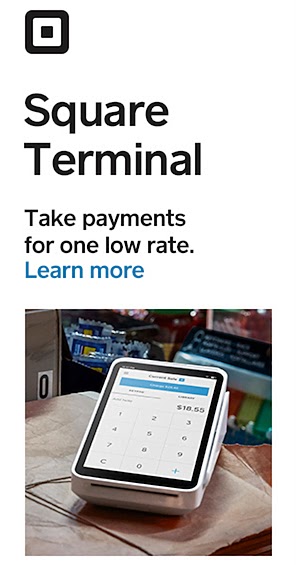
Notice how in both examples above, there’s a lot more space than with a PPC ad but even fewer words.
Despite the room, you still want to communicate one message as quickly as possible.
Square is a popular payment terminal for small businesses. It uses its display ad copy to deliver its message and instruct the reader what to do next:
“Take payments for one low rate. Learn more.”
The key is to provide product information that your audience can easily read at a glance. Then point your ad to a landing page where the viewer can find out more.
Stuck for ideas?
You can auto generate banner ads with tools like the Instant Banner Generator.
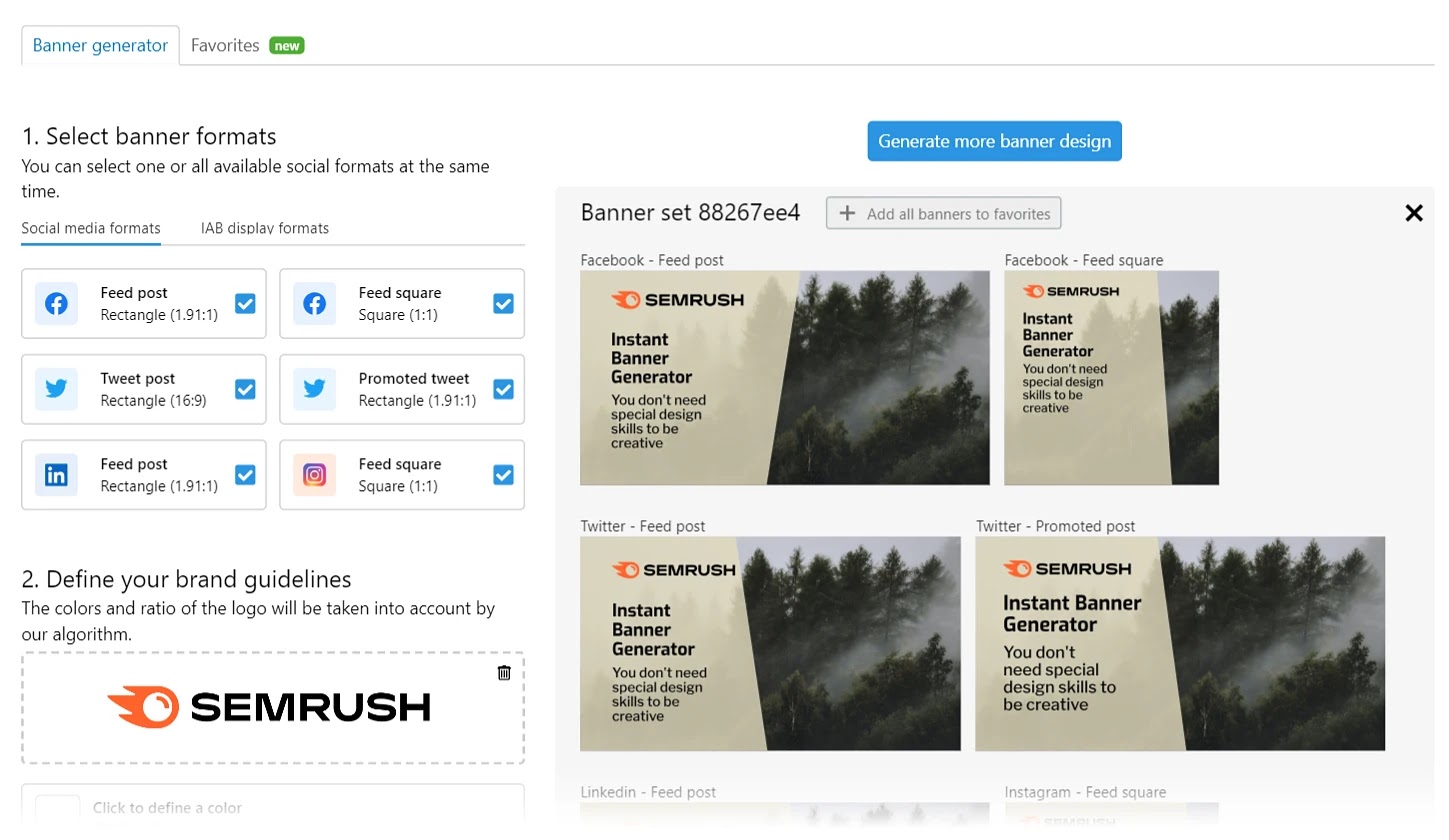
Choose your banner format. Add your content, preview it, then repurpose it for other platforms.
Video Ad Copy
Video ads are popular on platforms like YouTube and TikTok. The ad copy is often in the form of a script or captions, or it can appear alongside an engaging creative.
The format of a video ad refers to the text, videos, imagery, and any interactive features that the ad includes.
The ad function is what you want that ad to achieve. Including attracting new buyers, introducing new products, or re-engaging past customers.
Video ads can be incredibly engaging and allow a lot of room for creativity. Like this mobile YouTube ad for the Google app:
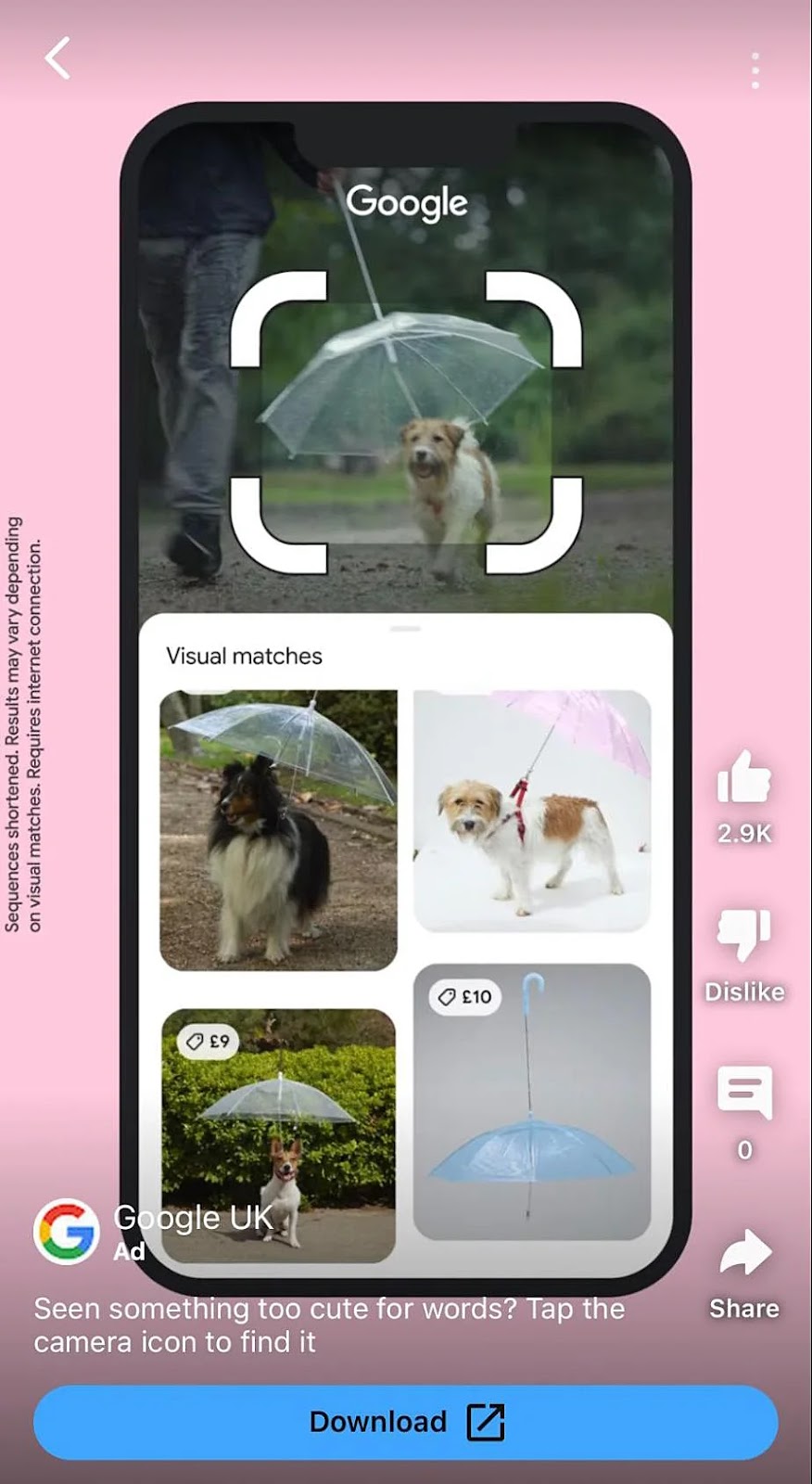
The format follows a searcher’s thoughts as they see a video of a with an umbrella.
The searcher wants to buy the umbrella. But instead of heading to the search bar, they tap on the photo. Google brings them a list of similar images and products.
The ad narrates what the searcher would be thinking as they go through the process of discovering and buying the umbrella.
The ad’s function is to teach users they can purchase products this way, reducing the steps to checkout. Ultimately making it more likely they’ll find what they were looking for.
The ad description reinforces that message in two sentences:
“Seen something too cute for words? Tap the camera icon to find it.”
There’s a clear CTA button pointing users to download the app, so there’s no need for CTA copy in the description. Keep everything brief and relatable.
While the Google app is a fairly generic product, other videos may be more tailored to an audience via target keywords.
For example, the search for “how to make deviled eggs” brings up a relevant cooking ad from Jamie Oliver:

It may not contain the exact phrase, but it’s related to beginner-level cooking.
Search for the right keywords for your video ad copy with tools like Keyword Analytics for YouTube app.
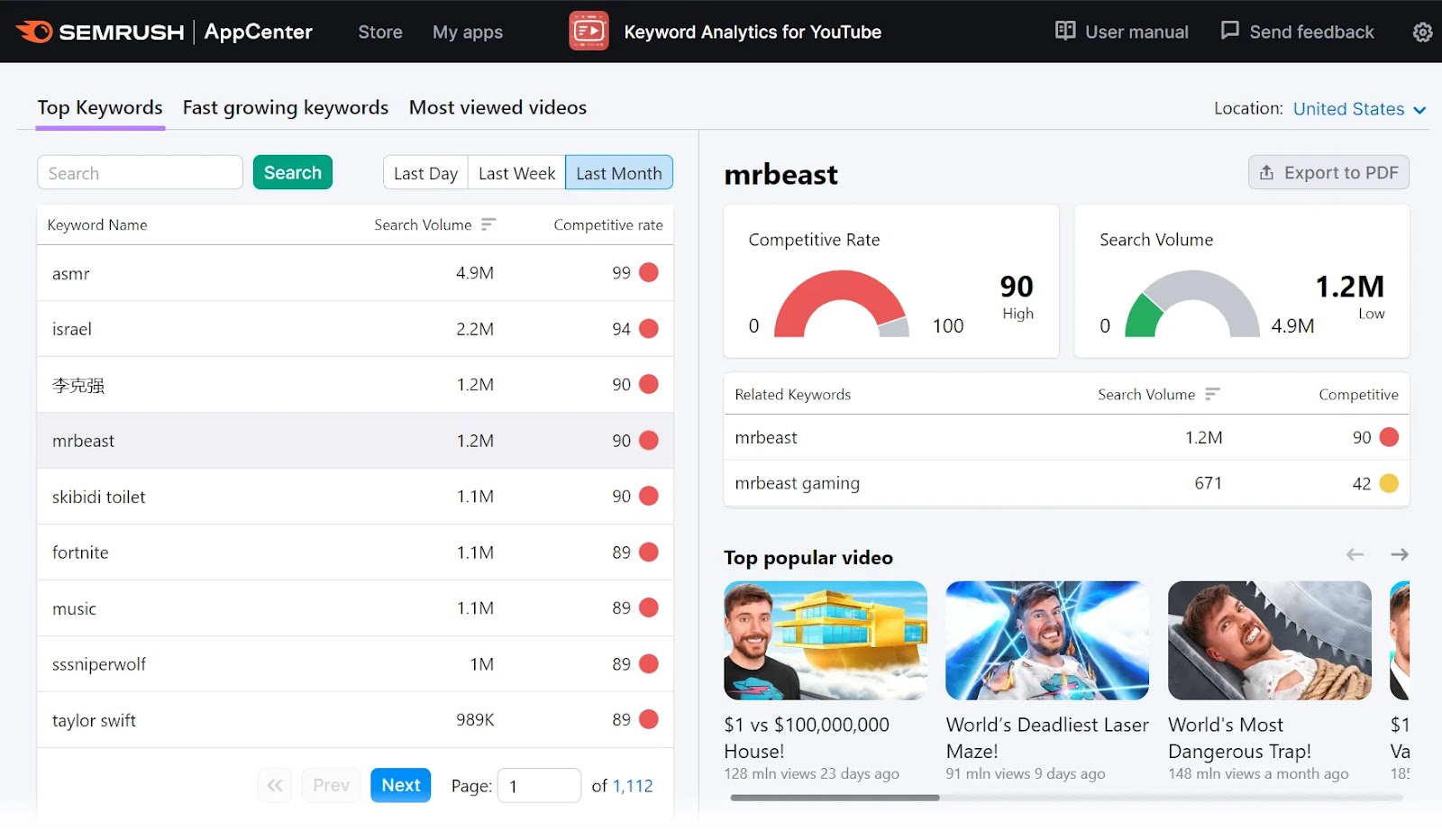
You can see what keywords users search for. Then capitalize on their timely popularity with a video ad that targets them.
11 Actionable Tips to Write Effective Ad Copy
Writing copy of any sort takes skill.
But it takes real artistry to creatively get across a critical message and persuade a customer to take an action in very little space. All while staying true to your brand voice, delivering within budget, and fitting your content into the format’s parameters.
There are certain copywriting techniques that have proven themselves to be effective time and again. Below, we’ll explore 11 tips to help your ad copy resonate with and convert your target audience.
1. Solve Your Audience’s Pain Points
Understand the pain points of your target audience to help you create relatable messaging.
With so many messages bombarding your audience at any given moment, it’s critical to write ads that actually mean something to them.
If you really want people to stop and look at your ad, address points they’re truly grappling with. Not just issues you brainstormed around an office table, but actual data-backed pain points.
Let’s take this Dialpad ad about “good AI” which played during the 2023 Super Bowl:
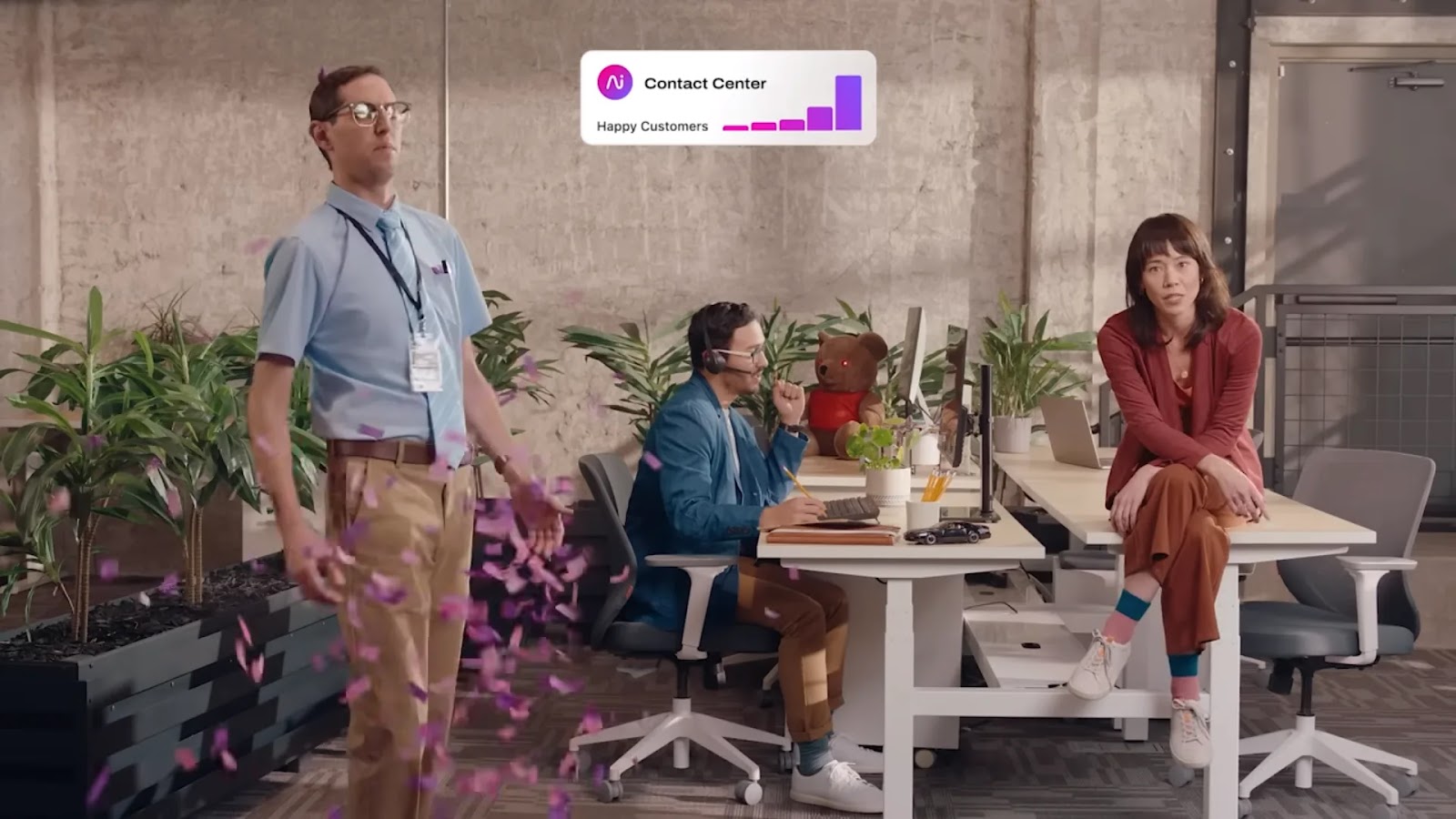
It lists things AI won’t do for you, like “make your coffee” and “clean the fridge.”
Along with things AI will do for you. Such as “help crush your sales goals” and “tell you who’s happy on customer service calls.”
Dialpad’s communication solutions mainly focus around customer service. So it chose to focus its ad copy on AI and the myths surrounding it.
It also zeroes in on specific issues its customers deal with every day—figuring out when a customer is upset on a call, for instance. That’s how Dialpad speaks to customers’ pain points through its ad copy.
So, how do you find out what will resonate with your target audience?
Simple: Ask them. Do this by:
- Running surveys
- Reading real customer reviews
- Tapping into online communities (e.g., Slack, Facebook groups, Reddit) where your target audience hangs out
Write down the words they use to describe their problem (like “how do I crush my sales goals”). And use those terms in your copy.
Further reading: If you’re still not sure who your customer is, read our Complete Guide to (Effective) Customer Analysis.
2. Study Your Competition
Analyze your competitors’ ads to determine any gaps or weaknesses you can capitalize on.
Maybe you need to create an ad that sells photo editing software. Look at Adobe and see what types of ads it runs. Like this one:
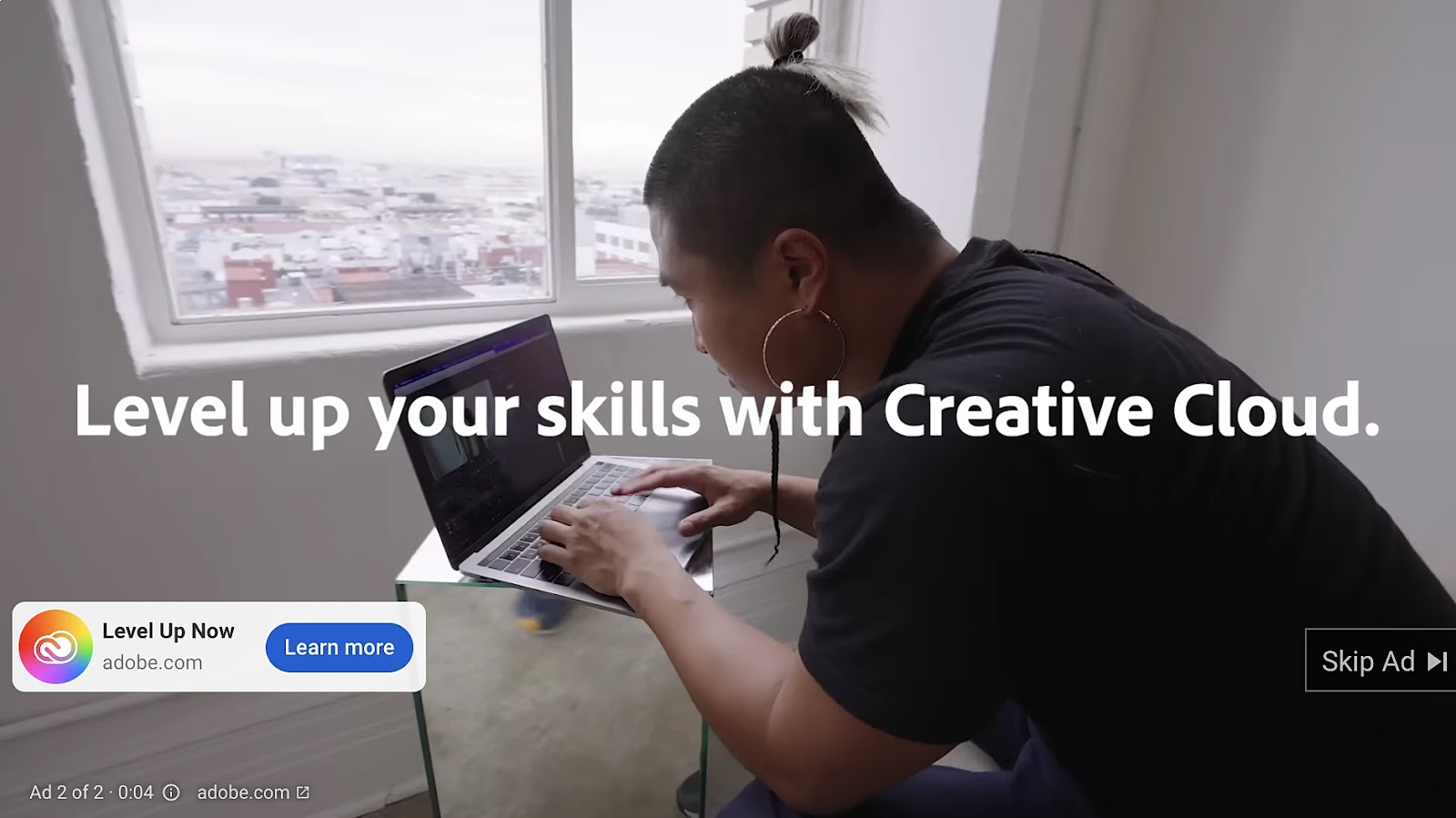
You notice that Adobe pushes its suite of tools. But say your research shows that customers are growing tired of the company’s complex products.
Use the findings from your investigation to establish a competitive edge.
You might want to explore ad ideas that touch on your software’s intuitiveness. Show users how they can start creating projects immediately—instead of spending hours learning how to do the simplest thing.
To see what your competitors create for social media, check out Meta’s Ad Library.
Simply enter a competitor’s brand name in the search bar. You’ll get access to a library of currently active ads on Facebook and Instagram.
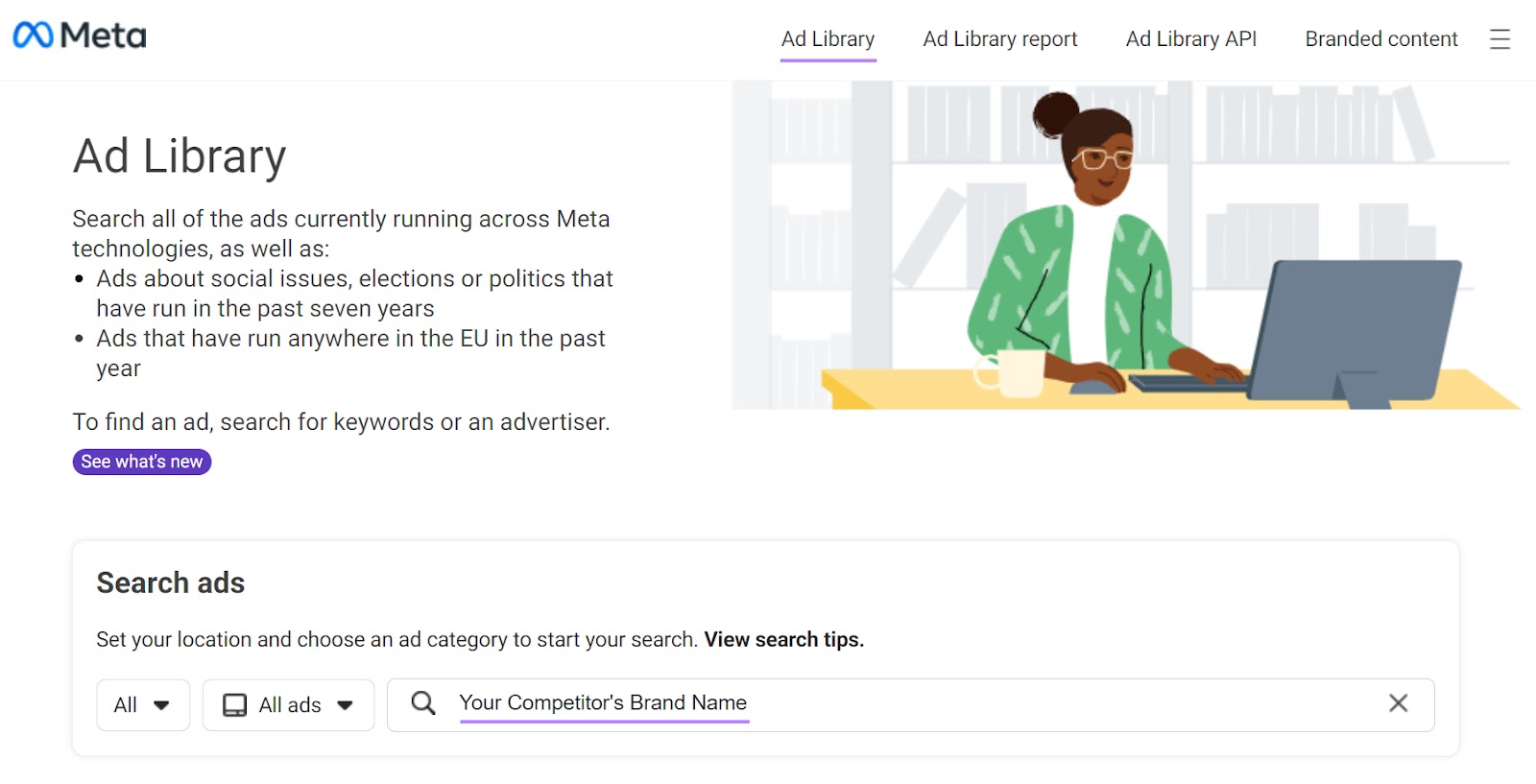
You can also identify your paid search competitors with Semrush’s Advertising Research tool.
Start by popping one of your competitor’s domains into the search bar. Hit “Search.”

Next, head to the “Competitors” tab.

A map of your biggest paid search competitors will appear.

You can also see the full list of paid search competitors in decreasing order of competition level.
Plus how many paid keywords your competitors rank for. And how much paid traffic their ads drive.
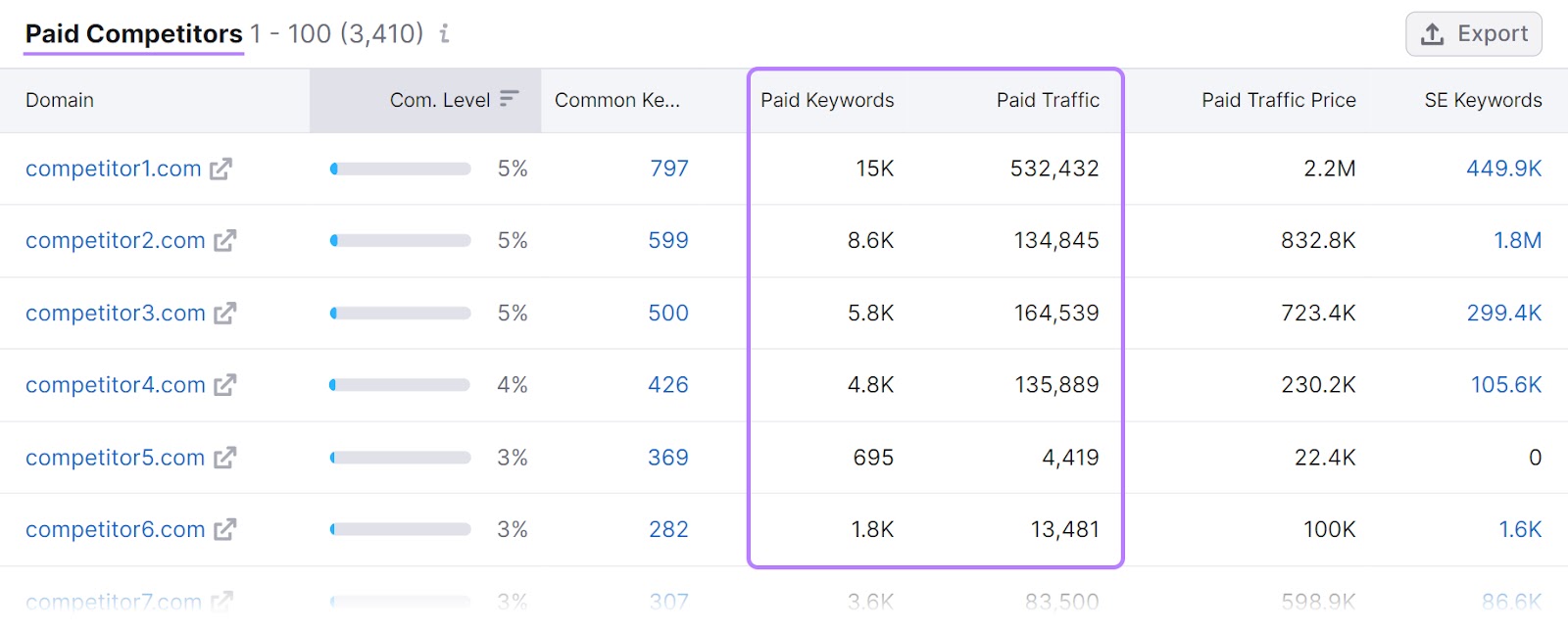
Click on a competitor you’d like to explore and move to the “Ads Copies” tab.
Here you can review the search ads your competitor is running to get an idea of what kind of copy works for them.
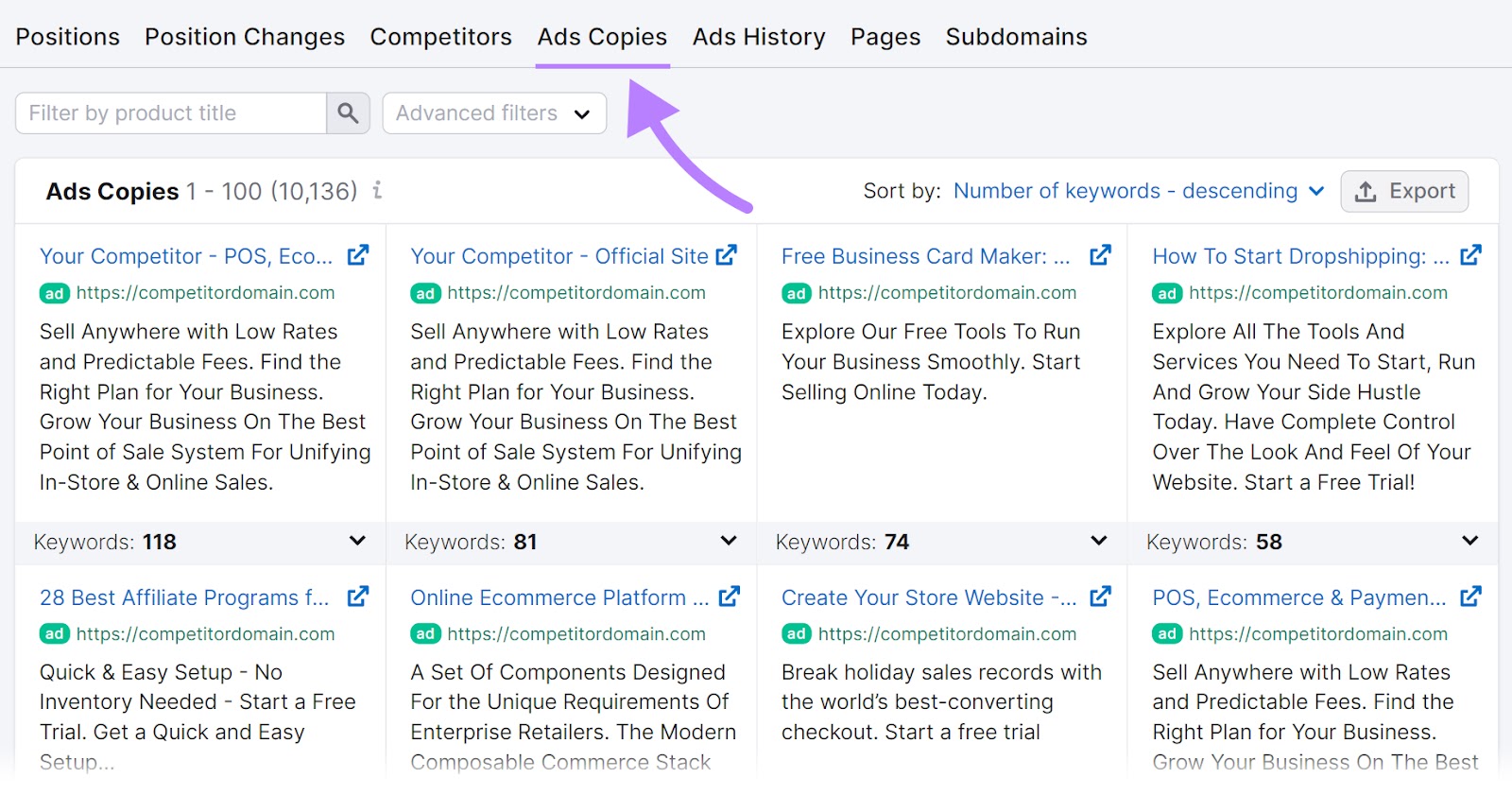
If you want to dig even deeper, the “Ads History” tab will report on the keywords your competitor targeted in the past. Showing you which keywords drove the most traffic and their cost per click (CPC).
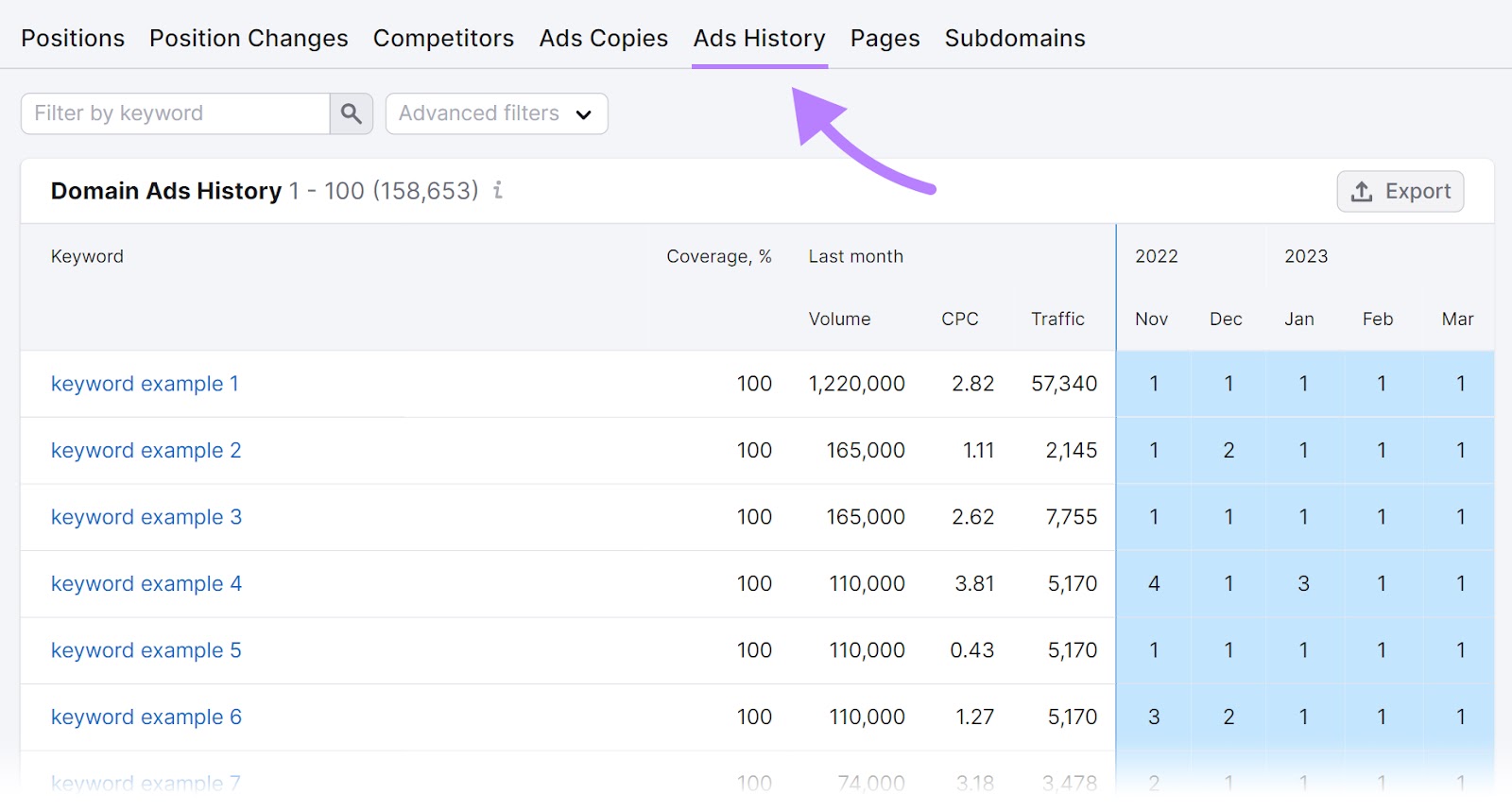
3. Highlight the Benefits
Go beyond listing features in your ad copy. Highlight how your product solves problems or improves customers’ lives to drive real results.
Is your customer looking for a “multifunctional form builder with drag-and-drop interface”? Or do they just want to create shareable forms without coding?
This is how Typeform communicates its no-code form builder ad:
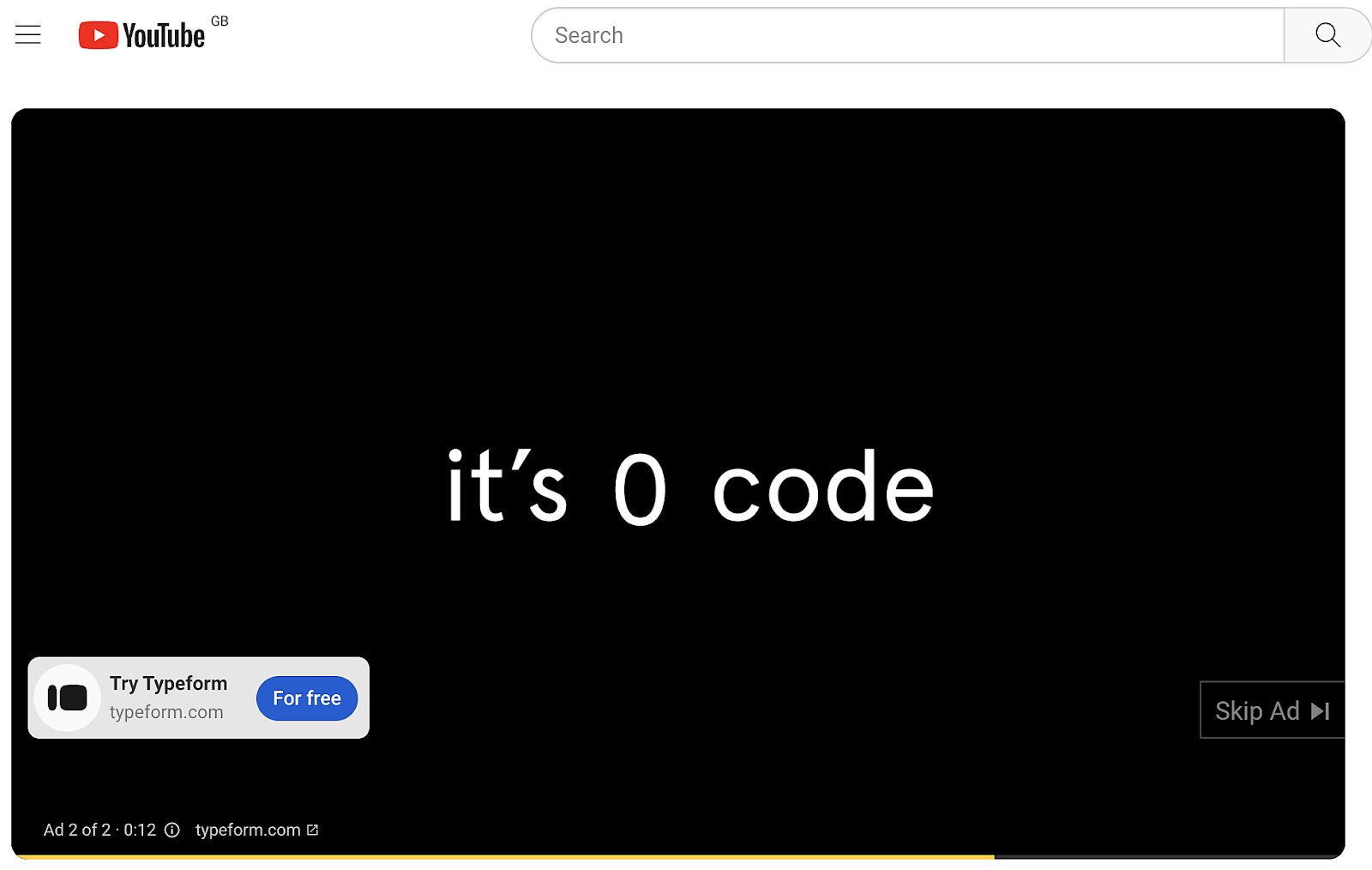
The copy runs as captions alongside a script.
At one point, Person A says, “Do you have to code that?”
Person B goes, “Nope. It’s zero code.”
Simple but effective.
Beware: It’s easy to get caught up in office-speak and jargon when talking about your product. Which quickly slips into marketing copy all the time.
We often see this when brands focus on selling their features rather than highlighting their benefits for the customer.
To really hit home, consider reading and analyzing customer reviews and brand mentions for language that resonates.
You can check out review sites and use tools like Brand Monitoring to find out how people talk about you online. And mirror that.
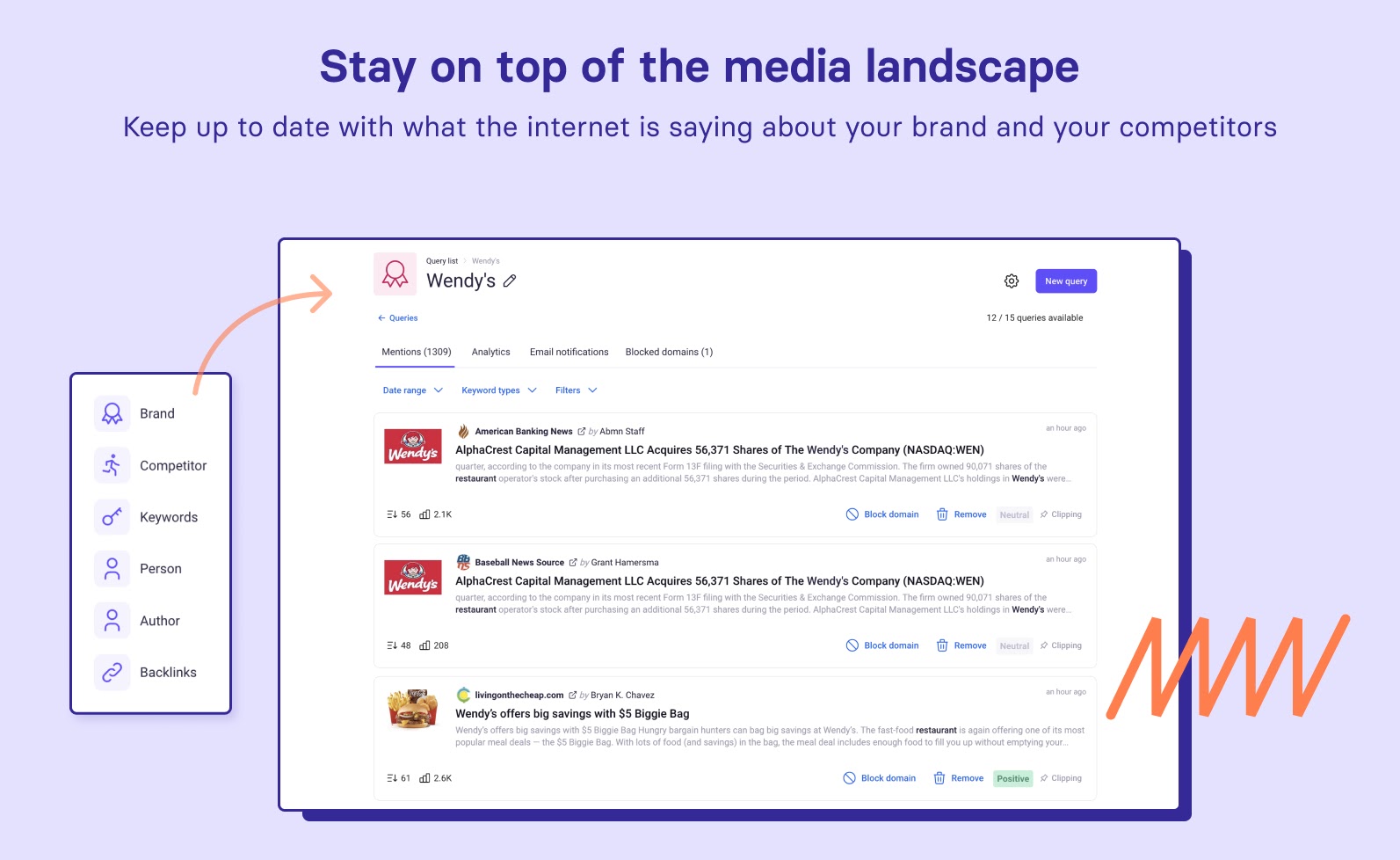
4. Talk Directly to Consumers
Make your ads feel like a friendly chat to connect with your audience.
Use the word “you” (the second-person perspective) to make the message more personal. According to a field study, the practice fosters a positive attitude toward your brand.
For example, luxury accessories brand Pom Pom London uses “you” in the ad copy and captions below. To help readers visualize themselves as owners of the advertised item.
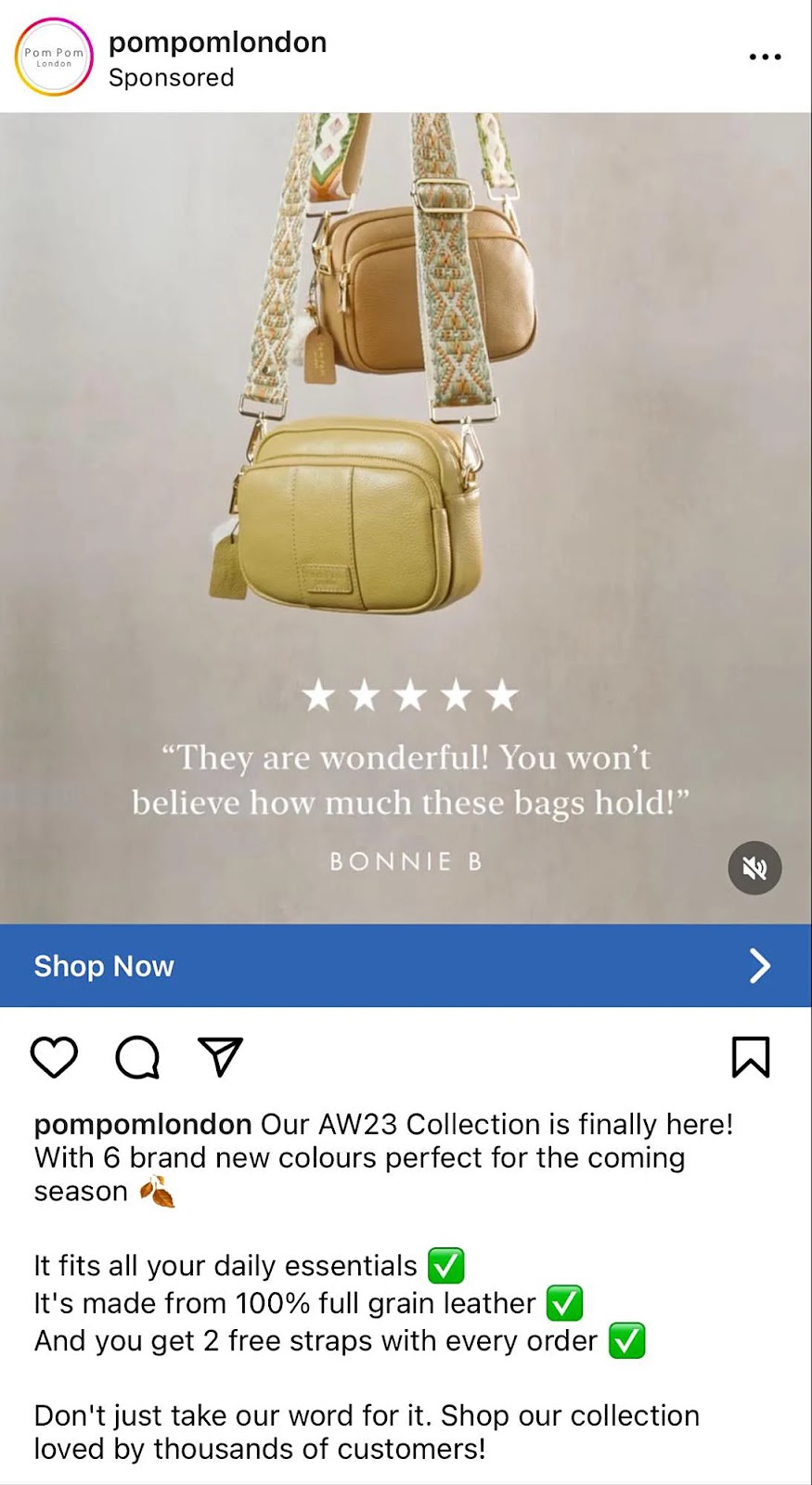
When coming up with your ad copy, write several versions in the second-person perspective. Find the most effective way to bring the reader into the message.
5. Use Action Words
Action words are crucial for motivating your audience to take the next step. Pick dynamic verbs like “discover” or “grab” to create a sense of urgency and excitement.
In the Facebook ad below, Spotify employs action words like “Check out” and “Explore.” They engage users and encourage them to try personalized playlists.
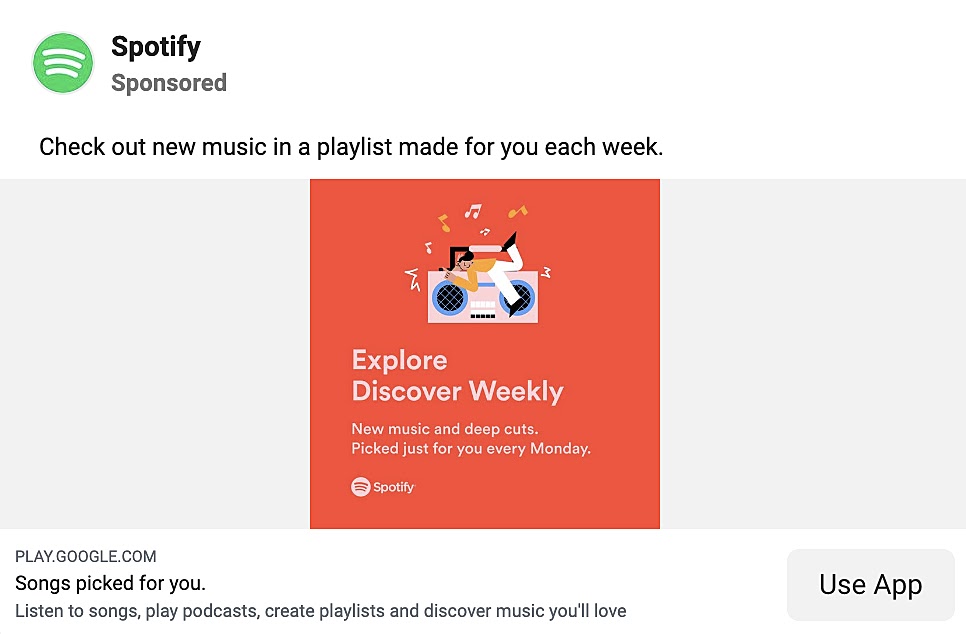
So, how should you include action words in your ad copy?
Say you’re launching a new collection of clothes. Instead of mentioning that “Our new collection is available,” go with something like “Discover our latest collection now!”
6. Add Emotional Triggers
Incorporate emotional triggers in your ad copy to potentially elicit urgent emotional responses that drive higher conversions.
There are many ways to trigger emotions. Using some of these popular words is a good start:
- Secret: Makes people feel like they’re in on something
- Hurry: Encourages the need to act fast
- Now: Increases urgency
- Connected: Helps people feel like they’re part of something
- Unwavering: Reinforces the feeling of trustworthiness
- Discover: Ignites a feeling of curiosity
In his book “Buyology,” neuroscience expert Martin Lindstrom argues that emotions usually triumph over logic in buying choices.
Phrases like “Don’t miss out!” play on our fear of missing out (FOMO), encouraging quick action.
Similarly, you can announce a limited-time offer to instill a sense of urgency. And nudge potential customers to purchase before the offer expires.
This search ad copy for Taylor Swift concert tickets taps into the FOMO factor:
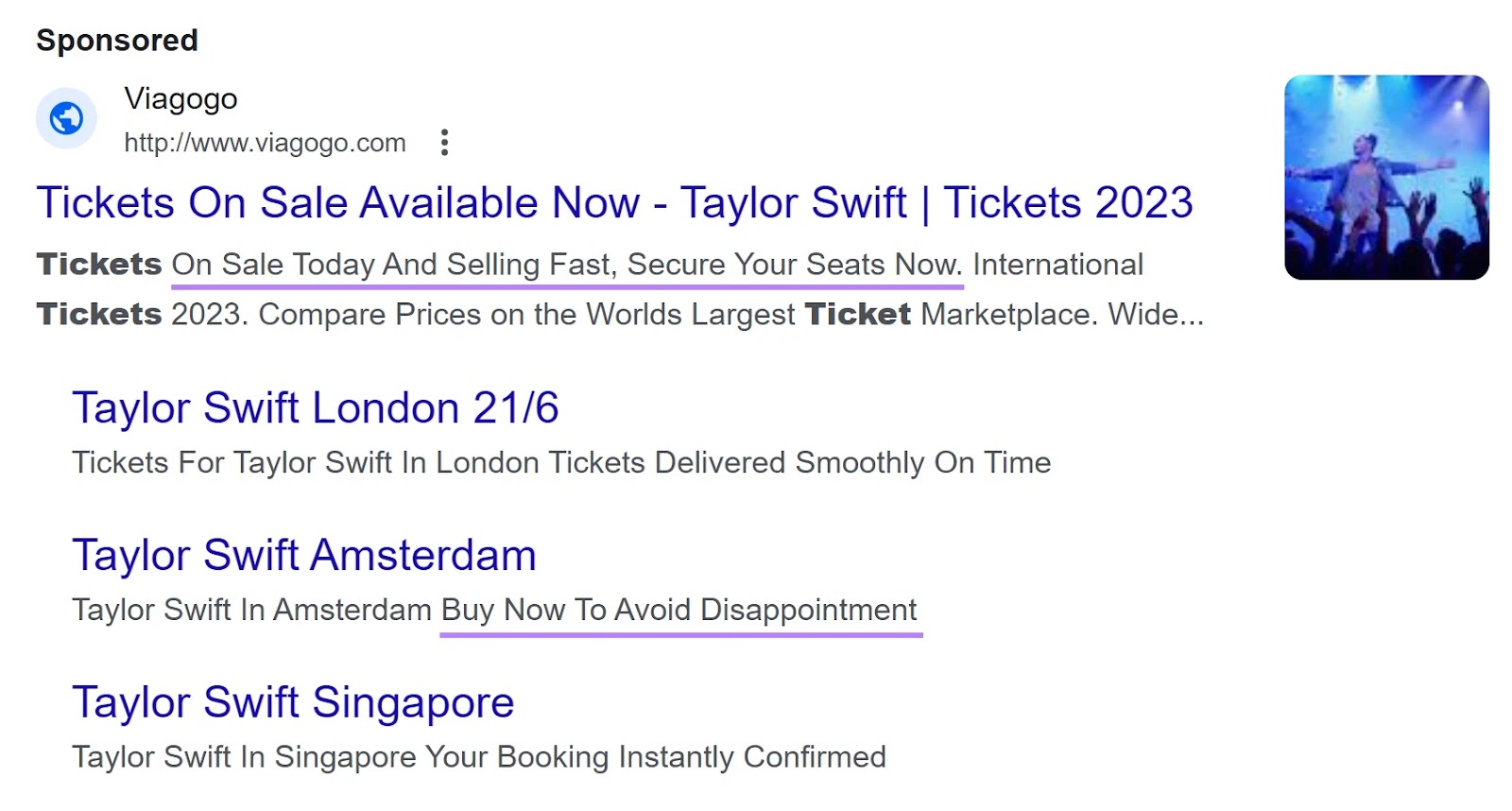
“On Sale Today And Selling Fast,” “Secure Your Seats Now,” and “Buy Now To Avoid Disappointment” warn customers not to delay their purchase action.
On another note, phrases like “Experience the joy of…” can foster a sense of happiness. You effectively encourage consumers to take action to realize that desirable outcome: joy.
Ultimately, make sure you consider the emotional response you want to create for your product. Write variations of copy that might elicit that response, and see which one works best.
7. Keep It Simple
Keep things simple to help your audience understand your main point right away. They may be more likely to take action.
People don’t want to work hard to understand your message. Plus, you’ve likely only got a split second to communicate.
Be aware: Complicated advertising can turn readers off and make your message unclear.
Consider Toyota’s approach in this ad:

Image Source: The New York Times
There’s no technical jargon and complex language describing the car’s fuel efficiency. Only simple, customer-friendly words.
How do you keep your message clear and relatable?
Tap into the voice of your customers.
Your best sources are online communities where your target audience gathers. Mirror their language, and you’ll resonate with their values.
8. Include a Strong CTA
Apply CTAs effectively to guide your audience on what action to take.
Written or spoken CTAs are an essential component of any advertisement. Without one, readers might be unsure what their next steps are. Spelling missed opportunities for your ad and your business.
What makes a strong CTA?
- Clarity: Write a crystal-clear CTA that leaves no room for confusion. Tell the reader exactly what action they should take.
- Relevance: Align your CTA with the context and content of your ad. It needs to make sense within your overall message.
- Action-oriented language: Use action verbs like “Buy Now,” “Get Started,” or “Read More” to trigger the desired response
- Value proposition: A powerful CTA often highlights the benefits a reader will enjoy from taking action
Sometimes, you’re limited to choosing from readily available button copy. Such as in Facebook ads:
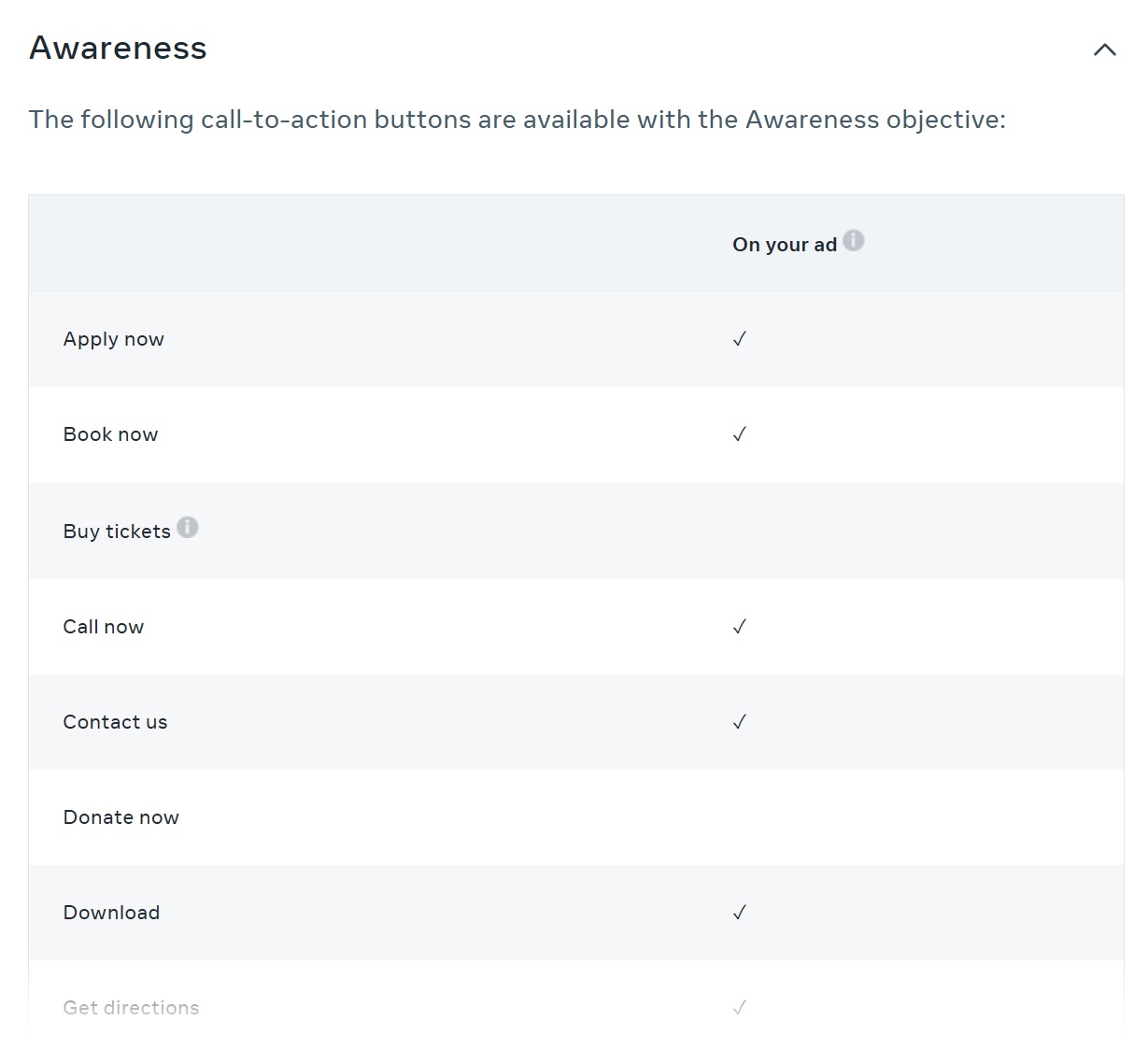
The William Morris and Ruggable ad above has a CTA in a button on Instagram.
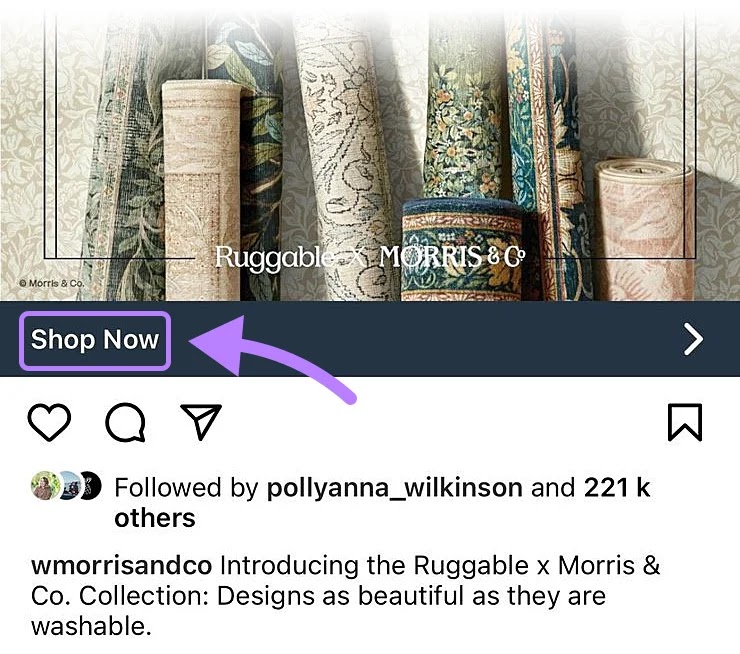
If you don’t have a clear button or link, decide whether it’s critical to communicate the next steps in your ad copy.
For example, this YouTube ad for British Gas doesn’t include a CTA in the ad. Because its goal is to spread awareness about its Olympic partnership.
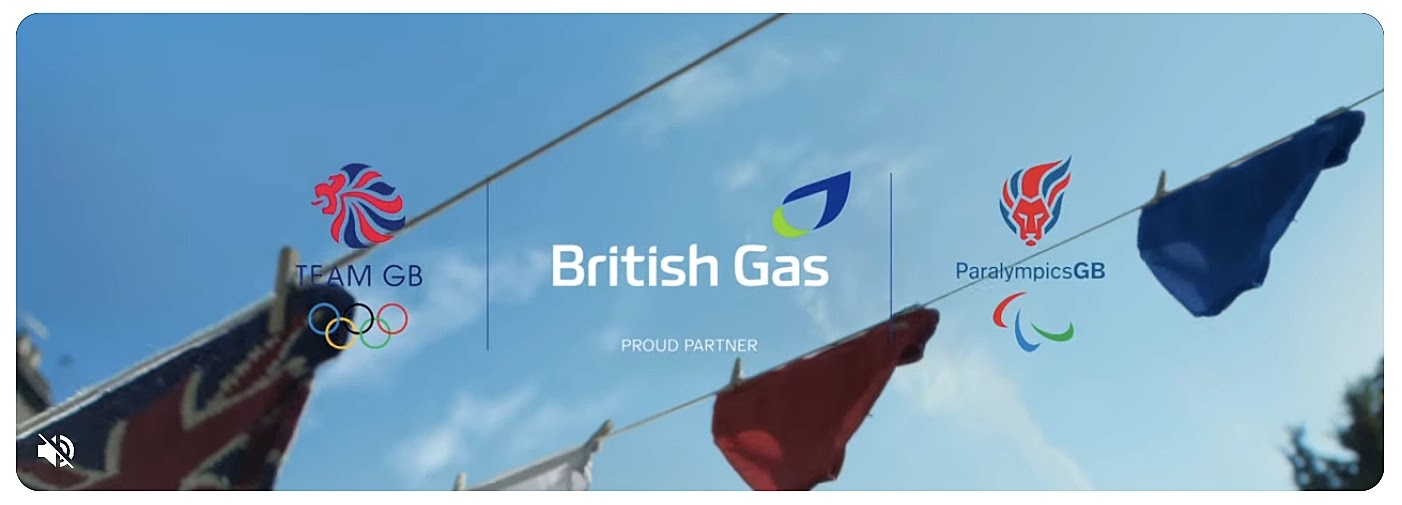
In other words, there’s nothing for the viewer to do next.
But the Square banner ad (shown earlier in full) does include a CTA in the ad copy.
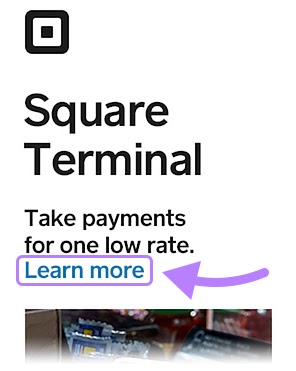
Square wants viewers to take an action—click on the ad and go to the landing page—so it includes instructions within the copy.
What if there’s no room for your CTA in the ad (perhaps for aesthetic reasons)?
You can sometimes include the instructions in the description below the ad. Depending on the ad type.
Like this WNU Instagram ad, which includes the CTA as a button and in the description:
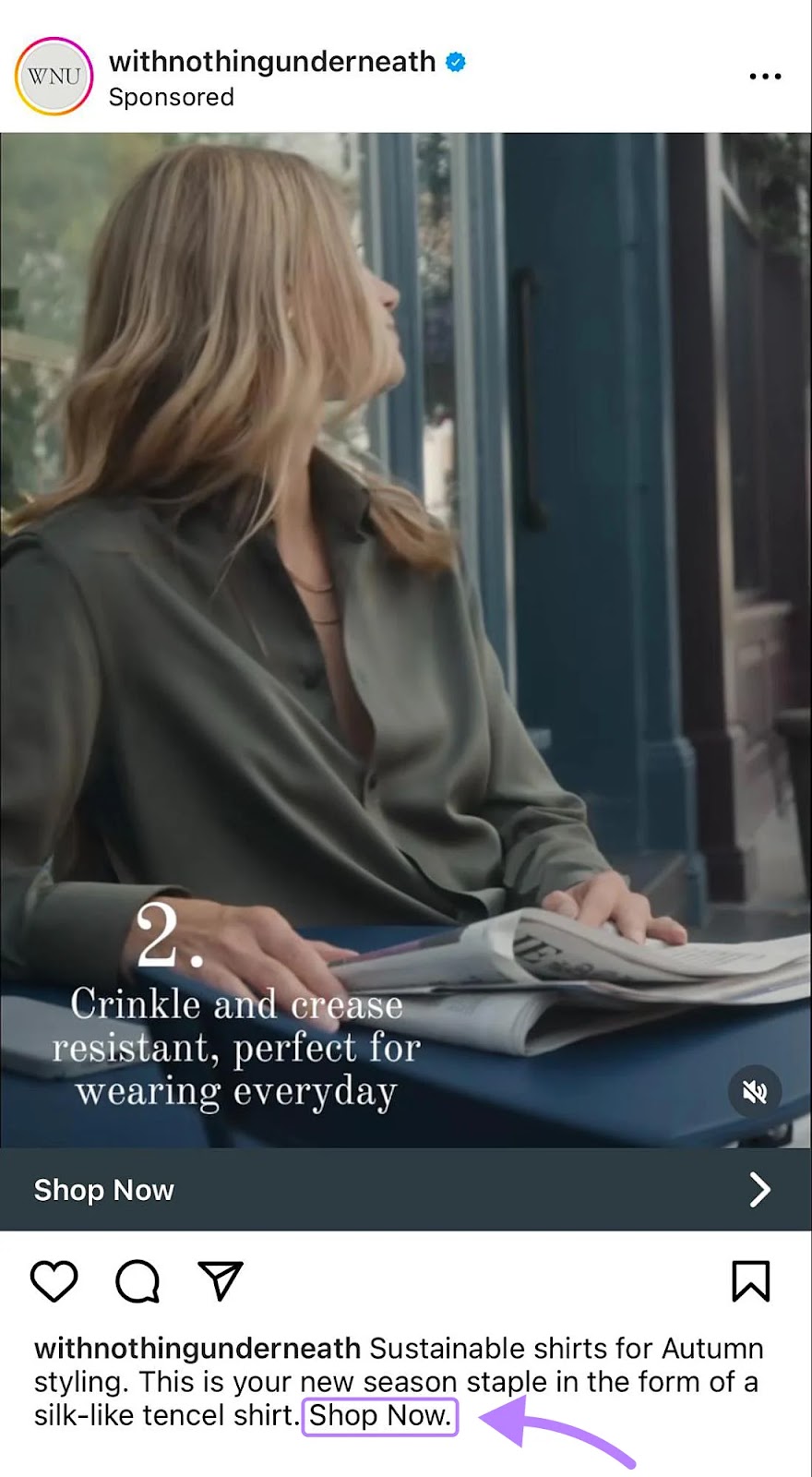
If the goal is conversion, make sure your reader knows what step to take next.
Further reading: 10 Attention-Grabbing Call-to-Action Examples
9. Make Your Ad and Landing Page Copy Relevant
Here’s how you can ensure ad relevance:
- Always review your ad copy and its landing page side by side
- Check that the messaging, tone, and visuals match
- Make adjustments to create a seamless customer experience
When users click on your ad, they expect to find information related to what you promised. If your landing page doesn’t align with your ad, you risk confusing and frustrating potential customers.
And confusion can ultimately lead to high bounce rates and wasted ad spend.
Take this ad for a lion’s mane supplement:

After clicking on the ad, you would expect to see a page that tells you all about the powder, its benefits, and how you can buy it.
And that’s exactly what you get on the Erbology landing page:
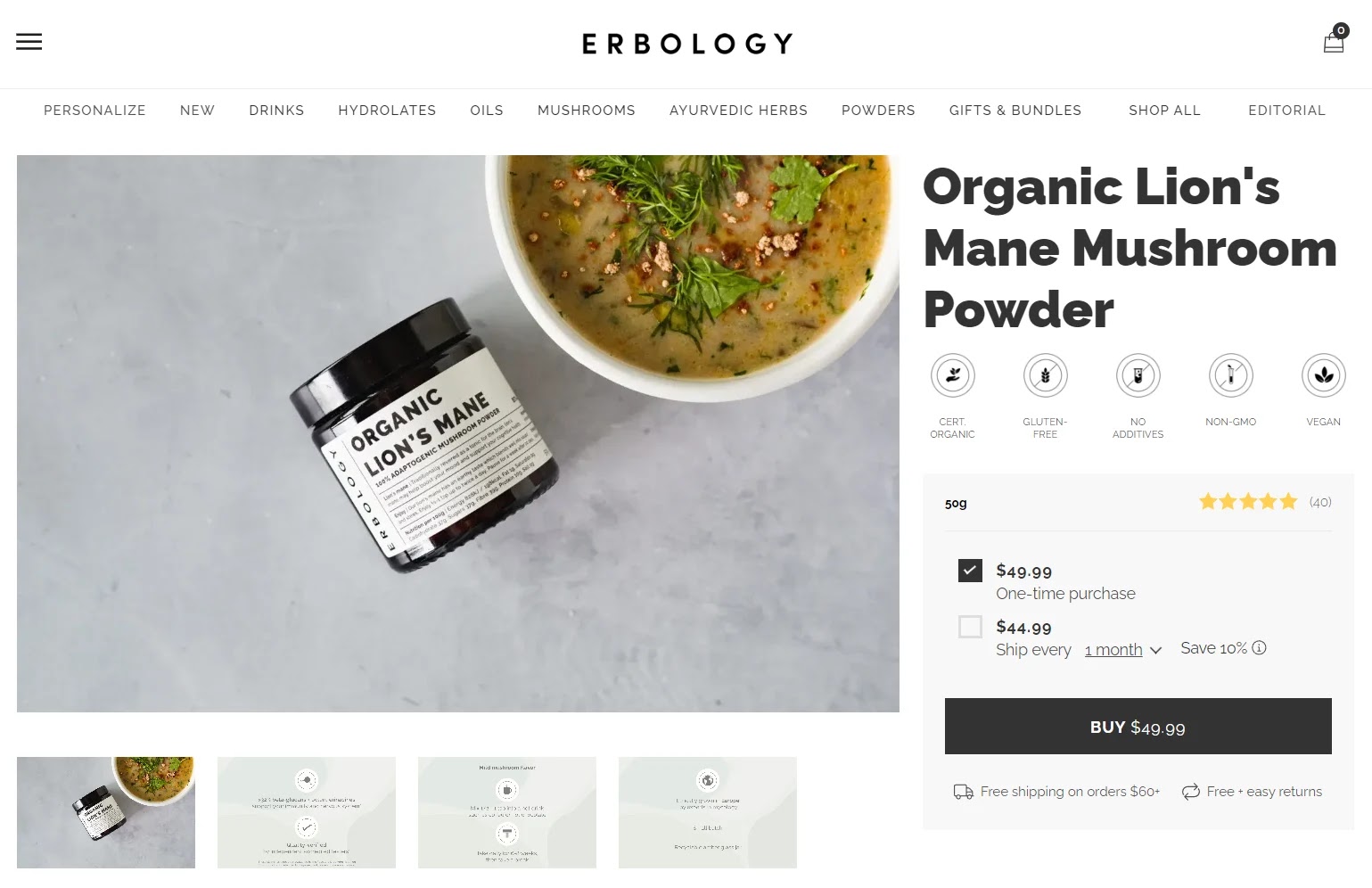
The tone of the search ad matches that of the product page. There are no surprises.
It’s now the landing page’s job to convince you to make a purchase.
10. Optimize for Mobile Users
You should optimize your ad copy for smaller screens. Stats for 2023 show that more than half of internet users worldwide (55.45%) browse on their mobile phones.
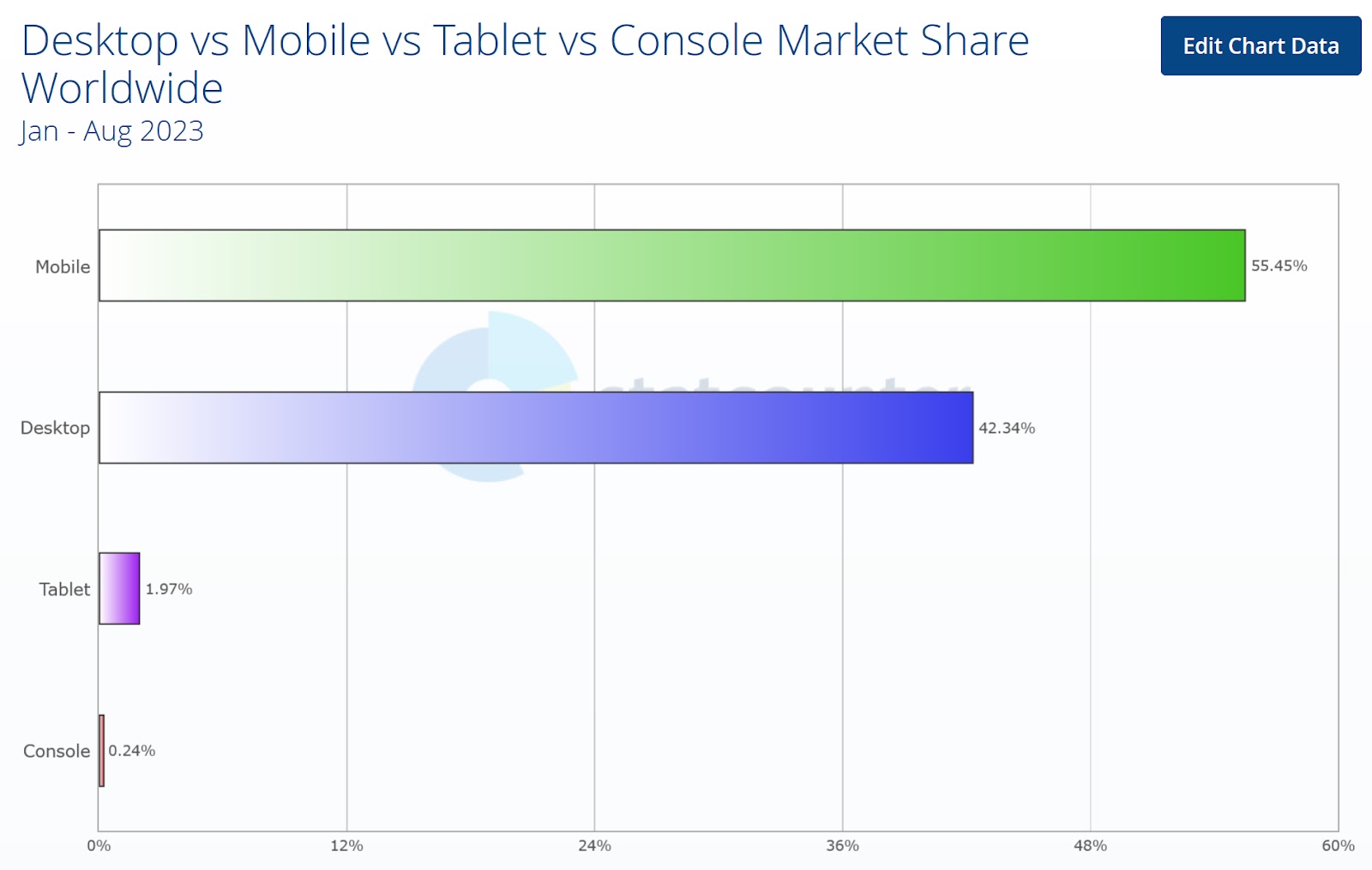
Avoid overloading your limited ad space with lengthy text. You risk overwhelming mobile users, leading them to scroll away.
Keep it short and sweet—the best ad copy is concise and easy to read.
According to Meta, one to three lines of primary copy is optimal (up to 125 characters).
Also consider ad size requirements for different screens. Work closely with the creative design team and get the size details upfront.
If you’re using Google Ads to upload your campaign, Google tools handle mobile responsiveness for you (the ad’s ability to adapt to the device).
It works like this:
You enter your assets, like variations of headlines, descriptions, and images. Then Google determines which combination to use based on the device.
The downside is you lose some control since Google chooses the combination for you. But the good thing is that your ads will be readable on any device.
Let’s look at an example of a YouTube homepage ad on desktop:

The video is long and landscape with two other ads queued up next to it.
Meanwhile, the YouTube app homepage shows just one ad. Like this:
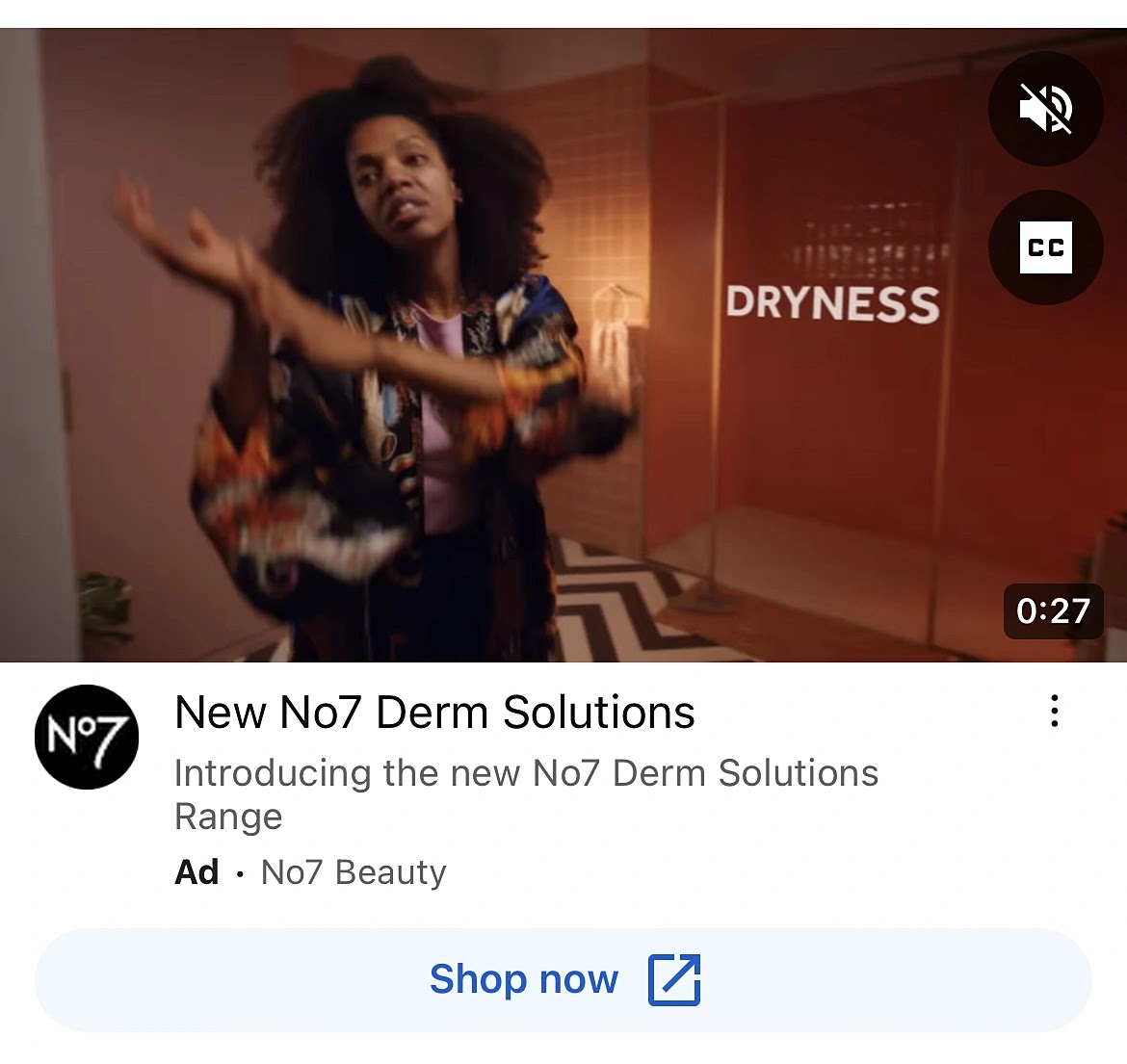
The ad copy on both screens is minimal. More like captions to go with a spoken script that may or may not play.
So, plan for multiple devices when preparing your ad copy.
11. Continuously Test and Refine Your Ad Copy
Try different versions of your ad copy to see which perform best. A common ad monitoring method is A/B testing—comparing two variants to determine the most effective one.
Test continuously to learn what resonates with your audience. The results can help you refine your ad copy to improve your conversion rate.
Semrush collaborated with a niche sports retailer to test different variants of the page title tag. The new variant included the phrase “Guaranteed Lowest Prices” in the titles on category pages.
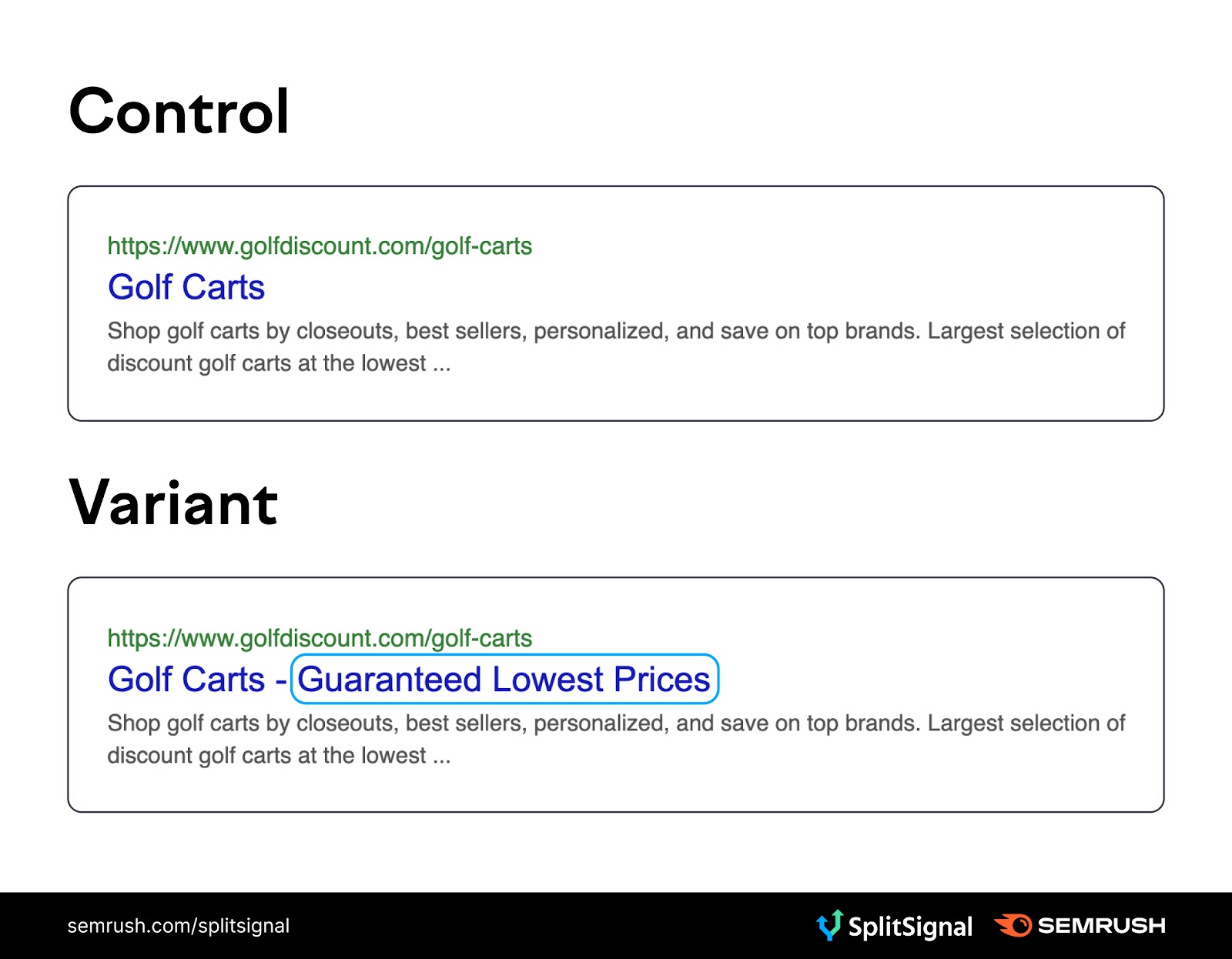
Using the SplitSignal platform for A/B testing, we observed an 11.4% increase in clicks among the test group within a 21-day period.
The phrase “Guaranteed Lowest Prices” is persuasive and encouraging to someone who wants to save money. And therefore more effective at driving clicks and hopefully revenue, too.
Here’s the deal. If you feel one version of your ad copy might work better than the other, A/B test it and assess the results.
Keep the best-performing version to help you raise your return on ad spend (ROAS).
3 Effective Ad Copy Examples
Now you know how to craft efficient ads, let’s review some examples of ad copy and what they do right.
Facebook Ad: Nom Nom
This Facebook ad copy from Nom Nom effectively combines visuals, a user testimonial, and a unique selling point to try its premium food:
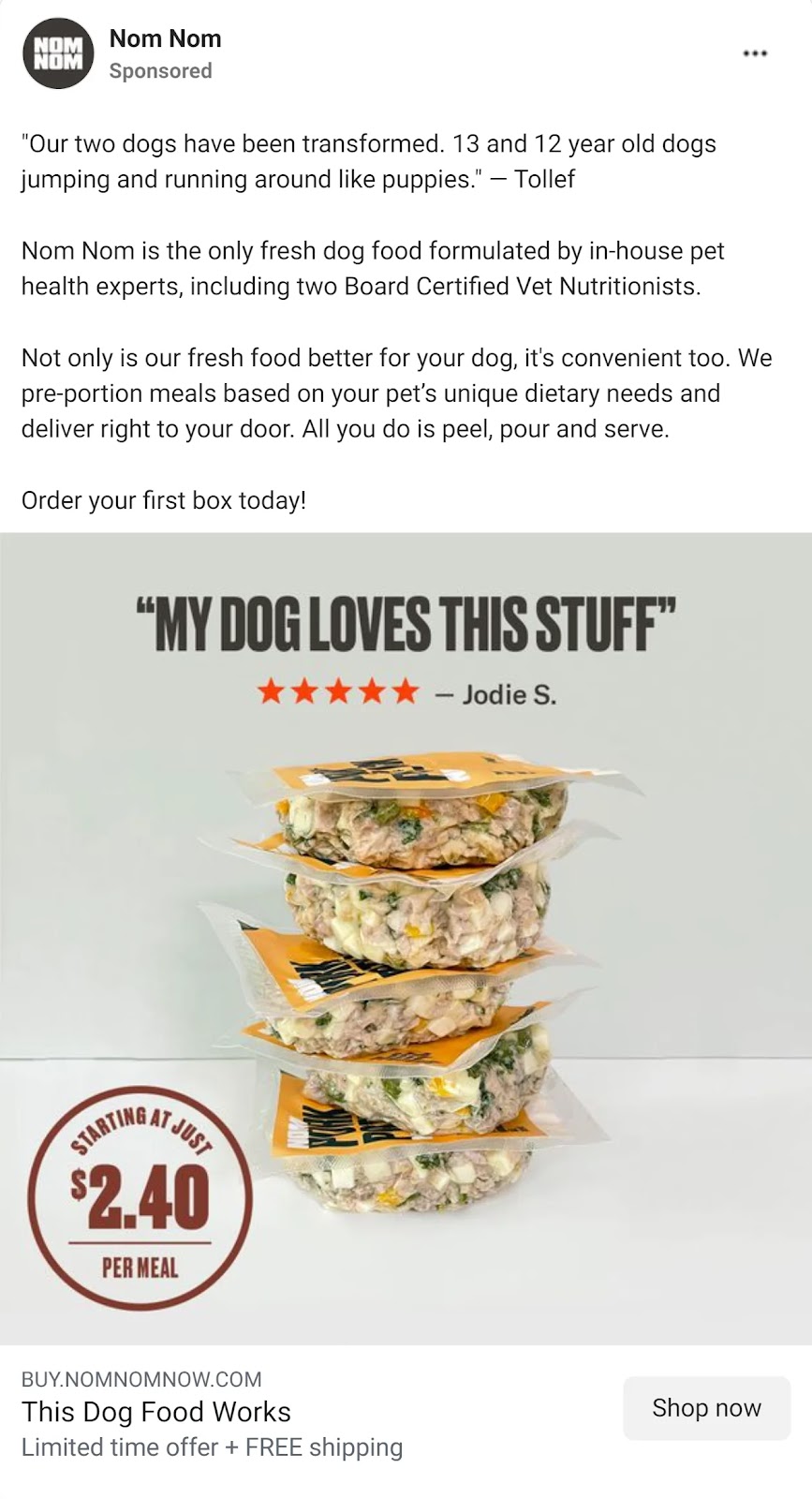
Here’s what the ad by the fresh food brand does right:
- Customer testimonial: Including a 5-star review from a customer adds product credibility and social proof, making it more trustworthy
- Compelling text: The statement “My loves this stuff” is a persuasive message that resonates with pet owners seeking quality food
- Unique selling point: Highlighting that Nom Nom is “the only food like it” sets the brand apart from competitors in its market
Search Ad: HubSpot
HubSpot’s search ad builds on the keyword “free CRM.” It aims to promote its free customer relationship management (CRM) software and highlight its key benefits.
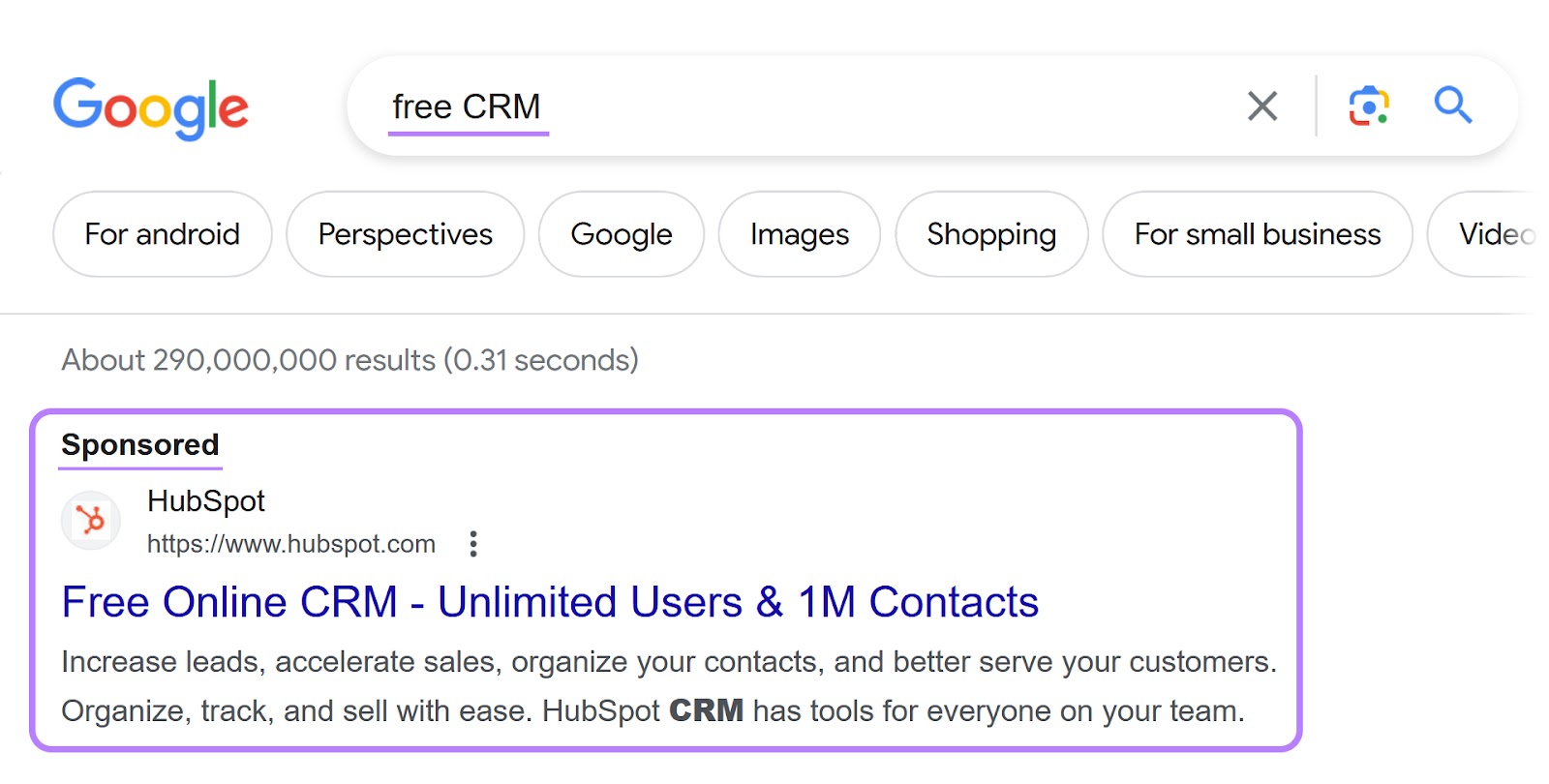
Here’s how the CRM platform ticks the ad checklist:
- Clear headline: “HubSpot’s Free CRM” succinctly communicates the primary offering. It’s clear that it’s CRM software and it’s free.
- Benefit-oriented subheading: The subheading effectively lists key benefits, such as increasing leads, accelerating sales, organizing contacts, and improving customer service. Providing a quick overview of what users can expect from the CRM.
- Concise and informative: The ad conveys essential information in a straightforward manner—crucial for search ads where users want quick answers
- Relevant to user intent: The ad copy aligns with what someone searching for CRM solutions is likely interested in: a free CRM with the advantages listed
Banner Ad: Brita
Brita’s banner ad is snappy, yet conveys the water filter brand’s main message.

Here’s what it does successfully:
- Copy length: The ad is short and punchy to ensure great readability
- Concise message: “Great taste, less waste” communicates the key benefit clearly and immediately
- Clear CTA: The “Shop Now” button promotes immediate customer action. No room for ambiguity.
Ready to Start Writing Effective Ad Copy?
Regardless of the platform, the essence of good ad copy lies in its ability to persuade potential customers to buy your product or service.
To succeed, you must truly grasp your audience’s needs. Identify their pain points. Then craft messages that offer them solutions or make their lives easier.
Embrace a customer-centric approach across your ad copy so that it resonates, engages, and ultimately converts.
Want help with your customer research? Get the latest data on what your target audience searches for online with Keyword Magic Tool.
Source link : Semrush.com
